#and the models are relatively low poly as well
Text
daxter saying "peeps be gettin' deep six'd"
#jak 2#jak 2 renegade#daxter#this animation is fucking goals btw its sOOOooo good#and the models are relatively low poly as well
352 notes
·
View notes
Note
okay so feel free to delete this message for asking you about TP crimes. but I'm curious if you have any purely aesthetic thoughts about the Link + Zelda designs, as well as the Zora designs, in TP? like how do you feel about the designs on their own, even apart from your distaste for the general atmosphere + story. again feel free to ignore this for TP crimes and no harm done!
yeah ok. disclaimer for those who don't know. i don't like twilight princess and i think the art direction was almost as bad as the story. do not argue with me about this. let's get into it. link first
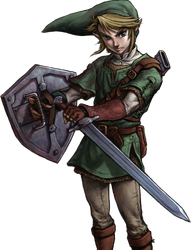
from a purely character-design standpoint I don't think this design is bad, but I don't think it's all that special either. it's very evocative of oot link, which I'm SURE was intentional based off everything else in the game. it does a decent job of complicating the outfit to the standards of tp's setting without going too overboard in terms of little details. the long hat looks stupid but i understand what they were going for. my biggest critique of the design itself is the desaturated color scheme, which I understand was present in the game at large but. I don't like it. I honestly do think that taking away the vibrance and colorfulness of loz takes a lot of the fun out of it. these games were originally for the NES. we're working off of 8-color pixel graphics. link's tunic should be eye-searingly green no matter how dark and brooding you want his story to be, because without that brightness and vibrance the games cease to feel like loz imo.
anyway. the real PROBLEM with this design, and with most of the art direction in tp, lies in how it was actually handled in-game. twilight princess was a game for the wii & gamecube, released in 2006. while advancements in graphics were GETTING THERE, the models were still relatively low-poly. The franchise had already seen a lot of success working with low-poly models in oot and ww, specifically because they leaned into the limitations of low-poly graphics and went for a more cartoonish, unrendered art style which made the blocky models seem purposefully stylized instead of limiting. twilight princess, however, did a complete 180 with the art direction and decided to attempt to HIDE the low-poly graphics behind over-rendered textures. this combined with the desaturated color palette of the character designs makes everything look very flat and lifeless.


in every close shot of link throughout this game i was constantly distracted by how awful the textures made the model look. the rendered folds of his tunic being slapped onto a flat surface, the rendering in his hair being an obvious coverup for the fact that it's one mass on the model with no physics, etc etc. the textures seldom rendered perfectly smoothly on the wii either, so the painted rendering would be strangely pixelated or blurry compared to the model's sharp edges. the game's lighting also seems to operate entirely in harsh black gradients, making the color and rendering choices on the model all the more obvious. Again, I understand that these are limitations of the medium the devs were working with, but i think that art direction that takes the medium into account and works WITH it instead of AGAINST it is almost always more successful than attempts to cover your ass after the fact, and i think that twilight princess could have been a more visually pleasing game if the art direction hadn't been so focused on covering the flatness of the models with hyper realistic textures.
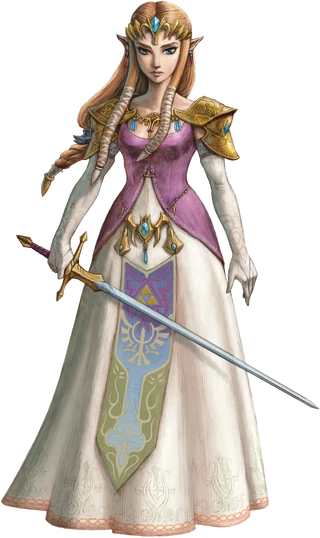
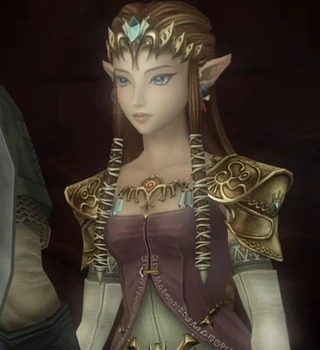
onto zelda. again, we have a theme here of taking the oot design and overcomplicating it. i think the color choices are better here than they are with link, but i would have liked a brighter pink on her bodice. I also think that the dress's neckline was... pretty obviously a sexualization attempt. there's a reason men love this zelda. imo if they were going to keep oot zelda's shoulder armor they should also have kept the breastplate-ish piece in the middle and the high neckline from that dress. you cant say ooh look shes a swordfighter see she has armor!! and then leave her fucking jugular exposed. no wonder she got possessed by ganon immediately. other than my general complaints with the over-rendering i don't have much else to say about her tho. shes fine

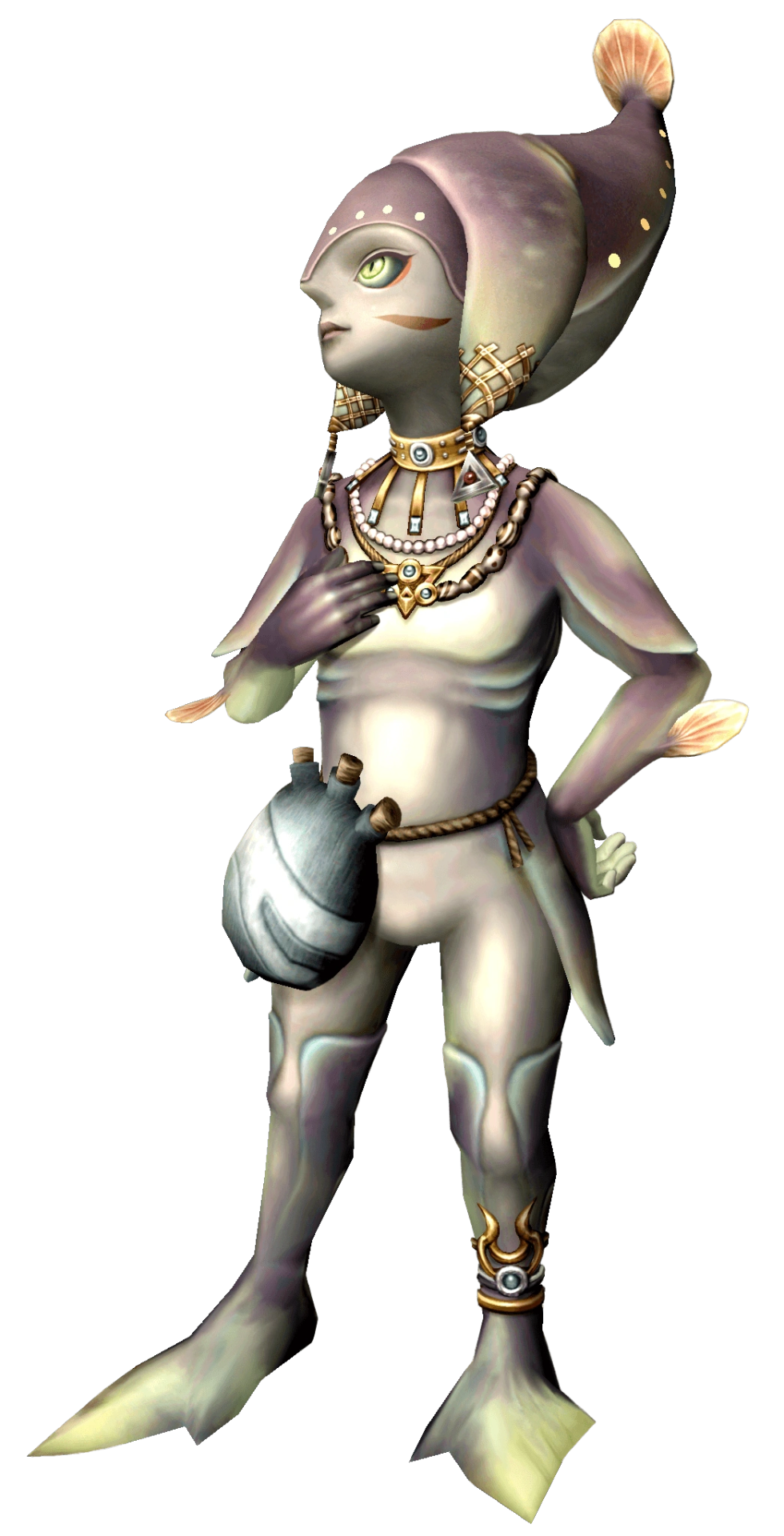

the zora tho... this is where i start to get pissed off. HOW ARE YOU GONNA DESIGN A SPECIES OF FISH PEOPLE BASED ON TROPICAL FUCKING FISH AND THEN REFUSE TO PUT A SINGLE SATURATED COLOR INTO ANY OF THEIR DESIGNS. the way these designs could all be improved by about a hundred percent if you just TURNED UP THE GODDAMN SATURATION. GIVE ME A REAL RED. IM BEGGING. UGGHHHHHHHHHH. i also think the ugly rendering REALLY shows through on these guys because they don't have a lot of detail on them to cover it all up. someone needs to explain to these designers that you don't shade with black. like. god. the designs truly are not bad in terms of like creature design i dont think but they are so DESPERATELY in need of color that it's fucking distracting. color is not your enemy guys please
#tp critical#twilight princess art direction my detested. bane of my fucking existence#COLOR IS NOT EVILLLL YOU CAN PUT SATURATED COLORS IN YOUR DESIGNS ITS OK. ITS NOT GOIGN TO BITE YOU#asks
65 notes
·
View notes
Text
𝚍𝚎𝚟𝚕𝚘𝚐_𝟶𝟸.𝟷
Moa's Ark & Zealandia
https://www.nzonscreen.com/title/moas-ark-1990/series
Moa's Ark (1990s TV series) opening animation. It was during the 90's that scientists formulated the "Zealandia" protocontinent theory and complexity of how species migrated over time, putting the last nail in the coffin of the idea that everyone got a free ride over on a piece of Australia. Going through Aotearoa's natural history doco archives has been a lot of fun.
Hello again! I took a bit of a break in posting long- form updates, but I think there's enough on my mind for a second batch of posts this week. After that there will again just be small updates on the Instagram until May - when I may have some sort of concept media for the sim to show off. For now I'll aim for a focused peek into a couple of aspects of it as usual.
This post is going to be all about the Moa, the species that got me hooked on this project. It's also going to be about species variation, and the tension between scientific accuracy and visual accessibility.

Moa skeletal reconstitutions at Te Papa Tongarewa, Museum of New Zealand.
A couple of interesting facts about the moa;
-We currently classify them as nine species. Here is a full catalog of every time someone thought they'd found a new one:

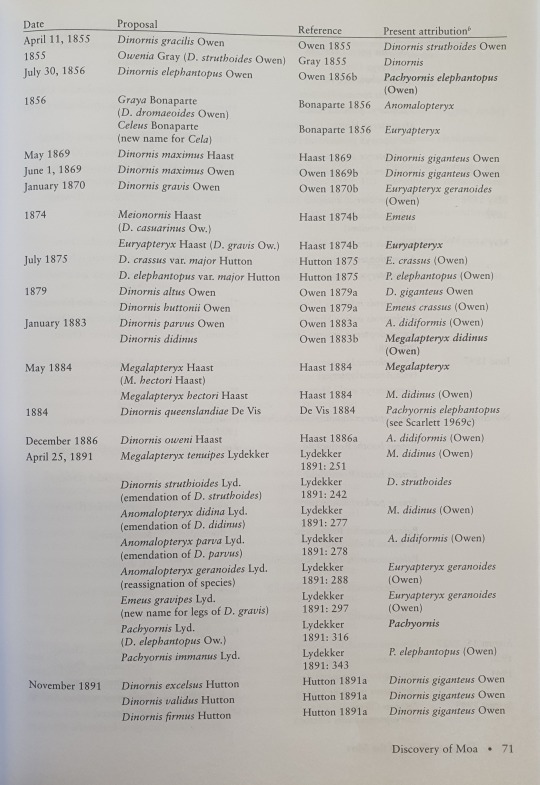
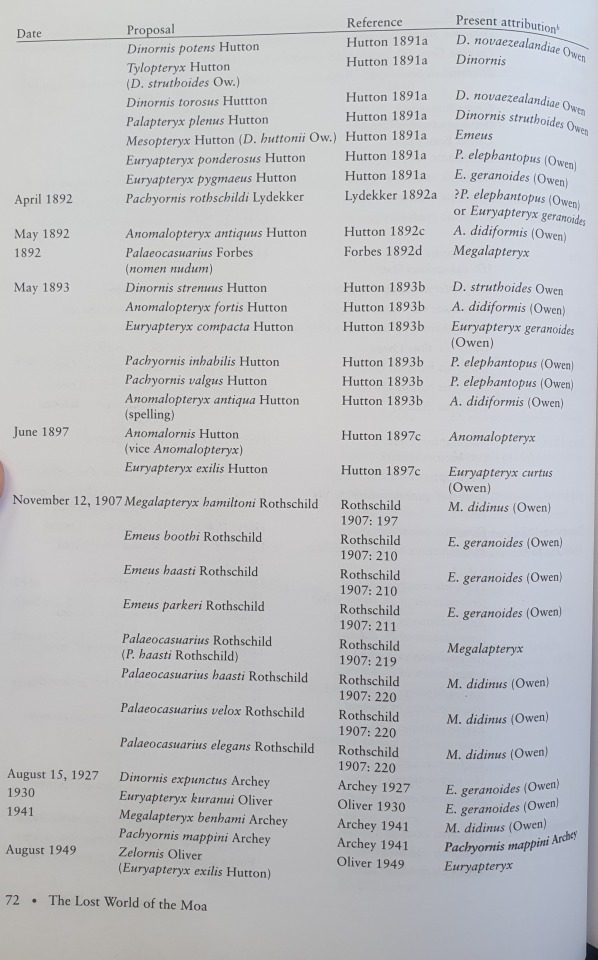
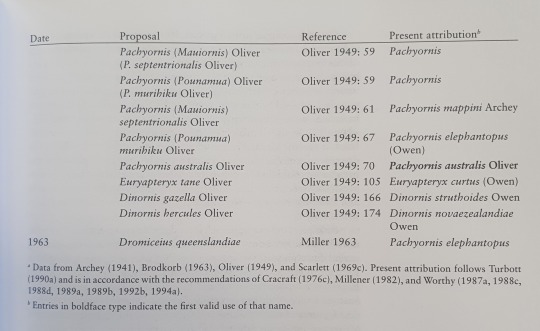
-Within many species, female moa can be more than twice the size of males (yes, this is one reason so many moa "species" were identified)
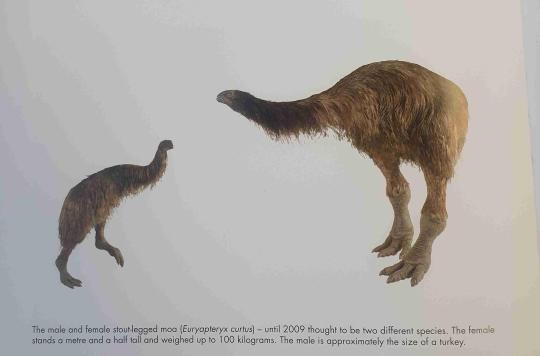
-Moa are unique in that they had no wings (not even the kiwi's tiny t-rex stubs) and, thank goodness because so many NZ species can be traced back to evolving from Australian fauna, their closest past relatives are South American tinamous rather than the emu.
-They also got a bad wrap for their past perception as tall, emu- like, big dumb grass grazers. Actually, while they're nowhere near as smart as multi-sense-foraging kiwi, they could identify and feast on a whole variety of twigs, herbs, leaves and berries - most of which were found in the more common forest than grassland.
This is why they have a bulky build and head-forward posture (until kinda recently, museum curators tended to give them that tall, emu/giraffe like posture, even adding extra vertebrae for show.)

Whanganui Regional Museum (This isn't close to the worst examples)
So; how do I even begin to approach the scope, as well as potential uncertainty, of data we have on the Moa?
Here's one way: Oversimplification!


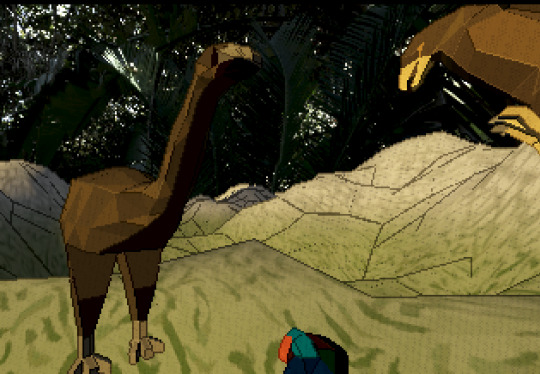
Screenshots from Godot editor & runtime previews for compatibility (web) mode and forward+ (basically more shaders) renderer. The camera is RTS- style; getting the runtime shots was a bit finnicky.
I've started to build low-poly models in Blender for the fauna, which in the future I'd love to rig for animation and get super technical with appearance variation. For now I'll focus on the system for placing them in the right biome and basic pathing behaviour, and the Moa will be a North Island giant moa based vaguely off this model for an AR national park exhibit: https://moaparkotorohanga.wordpress.com/2014/07/08/a-collection-of-moa-feedback-from-trevor-worthy-and-lizzy-perrett/
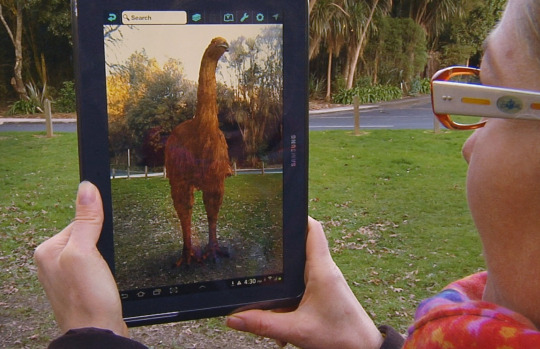
While I'm not working directly on the simulator for the next while, I am building this 2D tool to represent the moa's species variation; it is *incredibly* helpful to have just set up a system where I can add and edit instances of a broader Moa "class", and I'm looking forward to giving each species its visual character (the main creative liberty I'll be taking is colour coding from grey to brown to communicate which of New Zealand's islands each species populated, as well as their preferred biome (there's 3 main ones: subalpine mountain, wet podocarp forest, dry forest/ lowland)
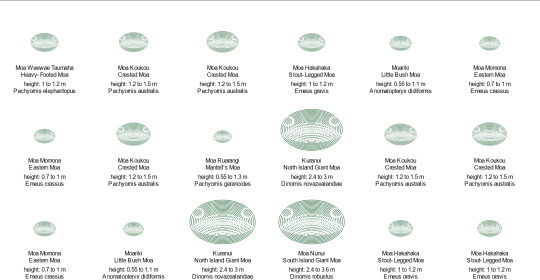
Moa "collection" project at time of writing.
If this exercise has highlighted anything though, it's just how difficult it is to reduce life's complexities to a single shape that represents a single numeric value. Those who read my last posts may remember that any given moa species' size may have varied over time and with temperature, (generally bigger during ice ages and smaller out of them) along altitude, (generally bigger and bulkier higher up) and just within species based on how they adapted to any given place. Not to mention the relatively massive lady moa.
And since we're only working with what's left of them all - the only intact gizzard samples proving that whole diet theory, and most of the remains we have to work with, are those found in Pyramid Valley in Canterbury (a swamp with surrounding mosaic of vegetation and forest) - who knows how to truly depict what life was like tens of thousands of years ago.



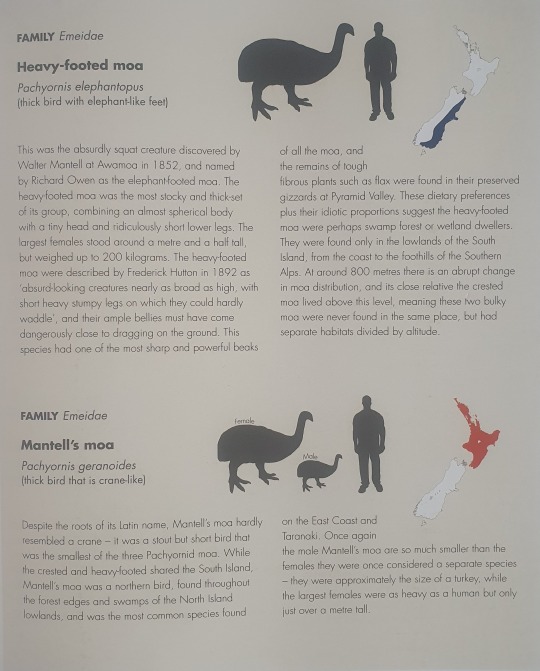

From the Moa book by Quinn Berentson


A very cursed JavaScript "spreadsheet".
So, very long-winded post. I hope you found something interesting within! Something that made you think about nature's craziness maybe. I meant to get across just how much there is to scientific communication, and I barely touched on how I aim to keep the overall narrative in focus (or basically be aware of it.)
I can't wait to work on this more collaboratively, with folks who really know their stuff about ecology and the cultural aspects of Aotearoa - I think the potential for collaboration and education is what's keeping me going with this project.
Until next time ! - here's some of my highlights from a trip to the Zealandia ecosanctuary.
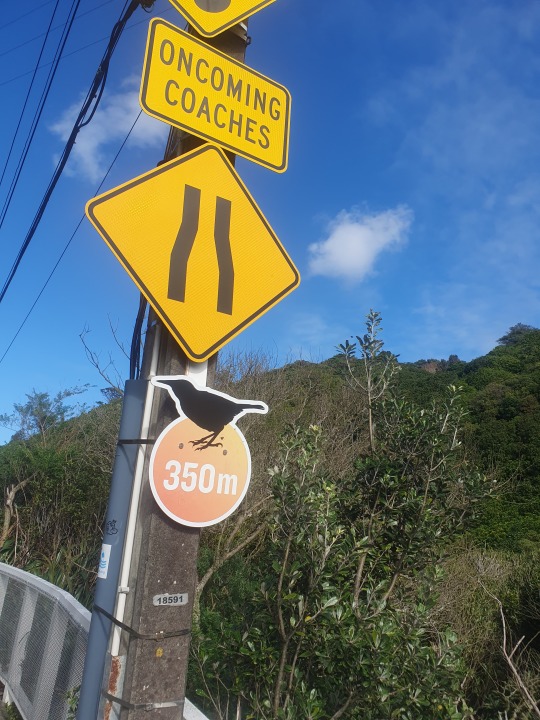
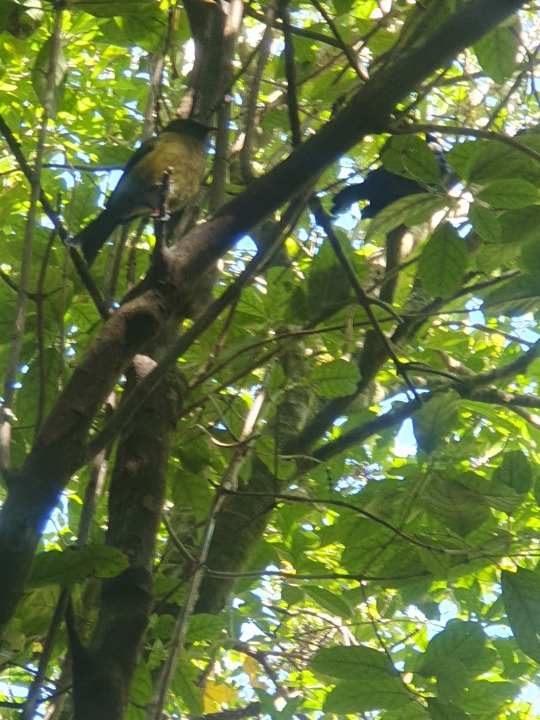

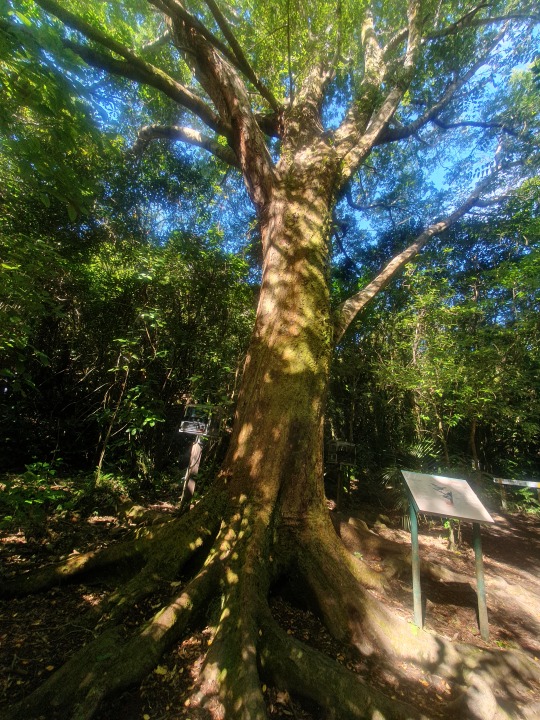

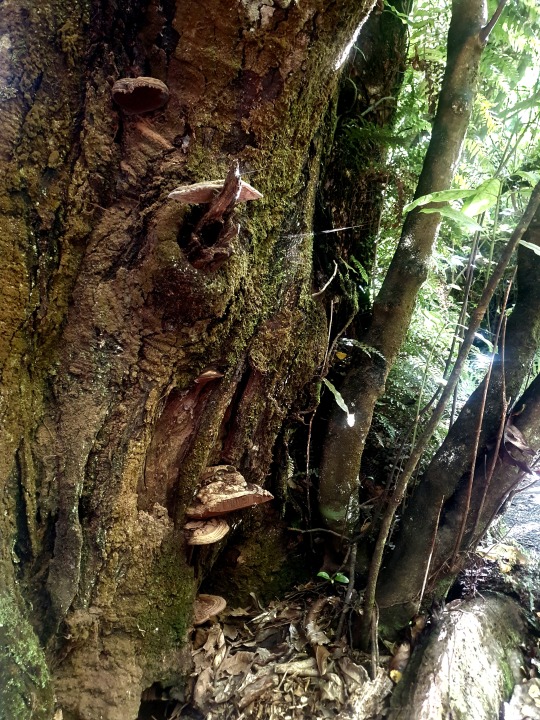
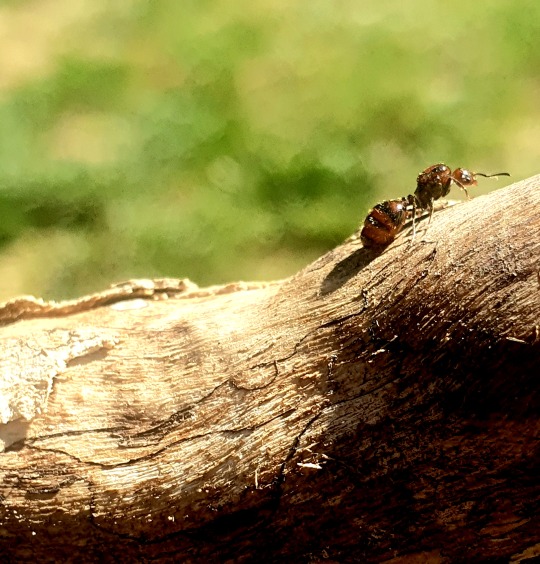

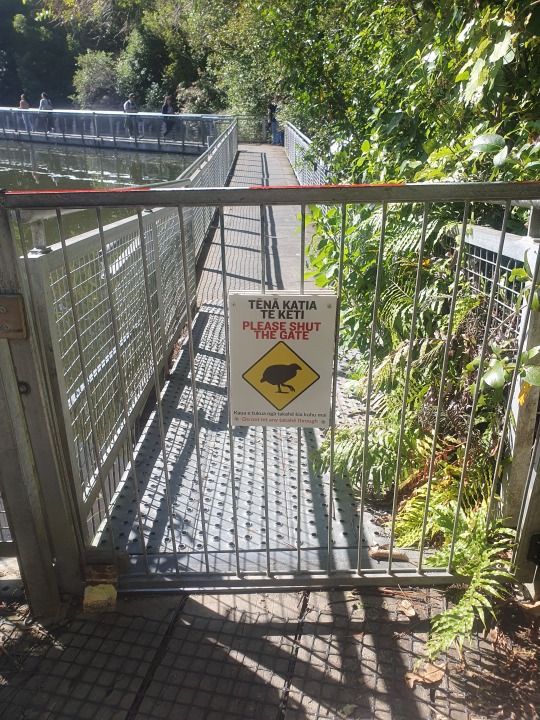

Kia hora te marino
Kia whakapapa pounamu te moana
Hei huarahi mā tātou i te rangi nei
Aroha atu, aroha mai
Tātou i a tātou katoa
Hui e! Tāiki e!
May peace be widespread
May the sea be like greenstone
A pathway for us all this day
Let us show respect for each other
For one another
Bind us all together!
#devlog#gamedev#indiedev#programming#birblr#moss#plants#aotearoa#oceania#natural history#nature#godot engine#javascript#ecology#science
3 notes
·
View notes
Text
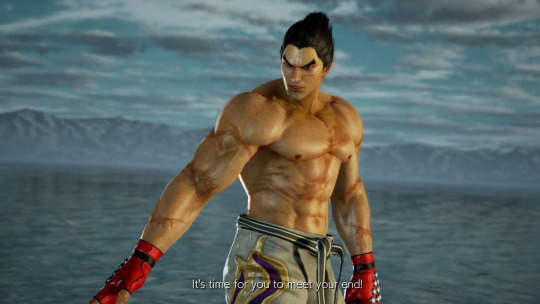
isnt it odd how this is not like. poorly rendered. looks fine. but it looks... less premium than a modern game. i think if you showed this photo to someone from 2005 they would be like oh... thats what games look like in the future. that doesnt look great. tekken 7 looks like good artistic ideas rendered poorly. the lighting is so unlike anything in real life combined with the relatively low poly models. their faces esp feel very half measure. theyre not an anime style but theyre not expressly realistic. realistic muscles with super exaggerated facial proportions. for some reason it just doesnt make any sense from any angle its not achieving anything beyond looking ok and portraying a character design as a model
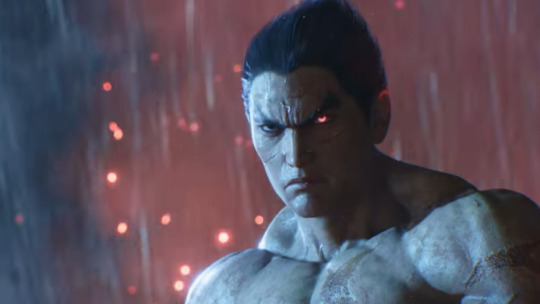
and so with tekken 8 you have this insane leap but using words to describe WHY it looks so much better is difficult. the lighting is better... but how is it better. well theres a direction its coming from and the granularity of the face modeling+light modeling makes it scatter across the face in a way that you see every day in real life when you look at other people. he looks like he BELONGS in the scene vs kazuya above looks like a model that was placed into a scene that follows its own light and color rules. no light bounce against him whatsoever. he is illuminated in a direction but its not REAL illumination its just a rote source pointed at him. i know it seems obvious but its just nuts how "realism" in terms of graphics results not JUST from emulating real world light behaviors but focusing on SPECIFIC behaviors. that SEEM subjective but its hard to disagree w/ the idea that focusing on the light behaviors in the SECOND image contributes to graphical quality more than what they focused on in the first image.
27 notes
·
View notes
Note
Hi, I hope that your day is going well! I don't know if this is something your okay with answering but I'm curious as to how you approach anatomy and how you create defining characteristics when drawing characters, like Texas and orchid?
i was like waiting to find time to draw some demonstrations or something, but I realized I’m gonna like
forget to reply to this if I wait to have the brain space to organize all that ahaskjdf
so here comes a text wall!!
so for the anatomy,
i think like most anything when it comes to A LOT OF INFORMATION
i go with macro to micro.
big to small.
so some exercises i still do is draw people silhouettes, but small!
but practicing with like general like bathroom symbol people/stickman
to like realistic silhouettes but simplified
i think it helps like
make a box in my head to hold the information of ANATOMY
and then when im just drawing
i like to think in larger chunks
like if you think about how 3D-modeling/sculpting goes
where there’s like big blocks to represent the torso and pelvis
low poly to high poly
anatomy’s just really hard cause it’s like
different proportions, how each element moves and then sits when you adjust.
but trying to find a mental like
organization to place all that information usually helps me!
and ofc patience with myself cause
it takes a long time for that information to really settle down
and for the creating defining characteristcs.
i think it’s about relativity.
like just like colors where
a color isn’t just inherently VIBRANT, it’s more about the colors surrounding that specific color. if the surrouding colors are more muted and the specific color is less muted, then it will look vibrant.
so same way
gotta start off with what feels like
a generic base for you. what’s your go-to person you’ll draw
that you think is an average look
and then you from there and make decisions on like
maybe 2x the size for the waist
or maybe 50% longer for the nose.
and then i guess last thing to realize that
bc it’s all about relativity. a character might only look very distinct when they stand next to another character who has contrasting features.
for example i have no idea if anyone but me knows this but
i draw texas with a longer chin than i’d draw another character.
(oh my god that reminds me to shorten up exusiai’s chin a bit, cause i did not intend for them to have a longer chin LOL)
OH that also reminds me
EXAGGERATION if you want to get across a point without there needing to be someone else to contrast for comparison.
like how everyone looks at my texas drawings and knows that she got thick eyebrows
cause i exaggerate the thickness.
and i think exaggeration is also relative to a style’s range. like going beyond the range a bit, just to get across a point.
but depending on the style, even a slight adjustment wil be BIG IN YOUR FACE DIFFERENCE. while other styles even a big adjustment might not be noticable cause the entire style is already pretty exaggerated
.__.
im so sorry if this is like overwhelming amount of info or really disjointed information
i just wanna assure anyone reading this that
it feels overwhelming but
if you dont stress about retaining it immediately and just
keep going and observing and being patient with yourself
you’ll eventually like start to notice and grasp the nuances of what you’re portraying.
i feel like it’s difficult cause like i know that for me
i had to go through a long process of learning to stop hating my art enough so that i can just
calmly look at what im doing, and instead of being dsitracted by how much i didnt like it, to start taking it little by little of like
oh what do i want to change.. and why.
and how do i make that change.!
#reply#aimlessartist17#oh god godspeed to anyone whoo's about to read this#im sorry i didnt organize it bc i knew i'll keep putting it off if i tried to organize my thoughts...#hjrambles
12 notes
·
View notes
Text
Create Project Phase continued
This week has included ongoing development of the prototype in Blender, collating responses to the survey I developed to obtain additional information about the RIFA and meeting up with my client to feedback on my progress and discuss the modelling process.
Prototype development
I selected the modelling approach I had used for Model 2 to carry forward. This was a more controlled approach to modelling and better suited to trying to keep the mesh relatively simple and the file size small.
Progress on the prototype model was slower than anticipated this week for a couple of reasons. The first being some of the photographic reference images I had initially chosen to guide my modelling were at slightly more angled views than a clear top down and side views of the RIFA’s head - this became more apparent as I started to look at where the other elements would join to the head and required some re-shaping to be done. I was able to resolve this issue by cross referencing the photographic images with a Micro CT scanned model of a RIFA from the Economo Lab from the Okinawa Institute of Science & Technology in Japan - see link below:
The above model is available to view but not available to purchase or download. My earlier investigations found that the technology to create a scan such as this of a specimen is not readily available in Australia. By rotating this scanned model I was able to screenshot a better set of reference images for the top, bottom and side of the head. I continued to use my original reference images for scale but referred to the scanned model images for the shape. Here’s a screen shot of my PC display below showing the use of the additional reference images to the right:
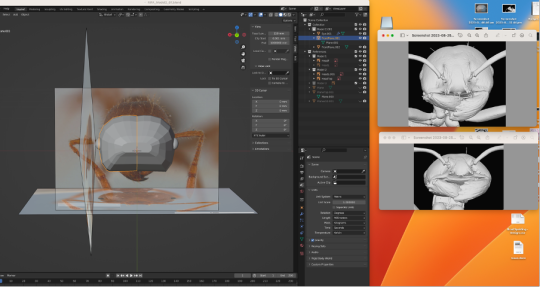
The second reason progress this week was somewhat slower was that during the development of the head shape and in my efforts to keep a low poly count (i.e. low number of faces on the mesh that makes up the model) I had unwittingly made a few rookie errors in the way I built the model. A clean and well-built mesh for the model is critical to avoiding issues with the model down the track – it’s like not lining up the bricks to build a wall or the posts for a fence. It takes time to fix but fixing the alignment is critical to getting the end result. Issues with the mesh aren’t always obvious and it can take a bit of troubleshooting to work out where things have gone awry and how to fix them. See here below just a couple of the issues I discovered which needed to be resolved. The first was that I had somehow turned my model inside out at some point during the build (see image below - the outside of the model should appear blue and the inside red). Thankfully this was easy to fix.

The second was that I had inadvertently created some tiny overlaps in the side of the model which only became obvious when I adjusted the view of the model to a smoother shape and these showed up as a crease (see image below).

By the end of the week I had reshaped the head more accurately (see below image), developed a clean model mesh and learnt a great deal about managing mesh topology but… had not yet added the mandibles or antennae!
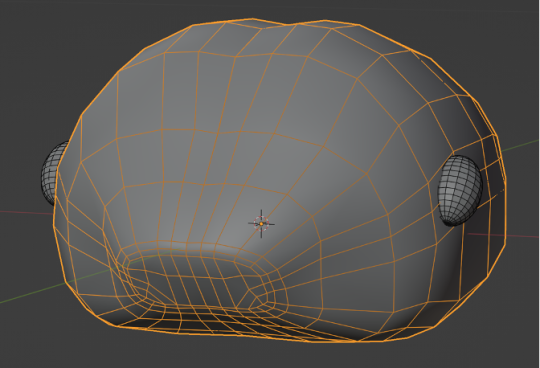
Survey results
I received feedback via my emailed survey from an academic researcher, a project officer working on the RIFA and a diagnostic entomologist with specialist knowledge of the RIFA. Feedback included the key and most useful identifying features of the RIFA and confirmation that the worker ant (major or minor) was appropriate to target for this model. The survey results also appeared to confirm our assumptions about where the model could be of use i.e. to support education of staff and to better engage the public.
The chart below shows the respondents selection of the critical features to ID a RIFA and differentiate it from other similar species. The results also indicate how at the moment that the key identifiers used with the public are mainly only matching the colour and size of the RIFA (using photographs) - a specialist team triages potential sightings and then visits to obtain specimens to confirm an ID. The availability of an accurate reference model of this invasive species has the potential to expedite aspects of the process of confirming positive sightings and save time and money spent on this.
Table - Key features for identifying a RIFA:
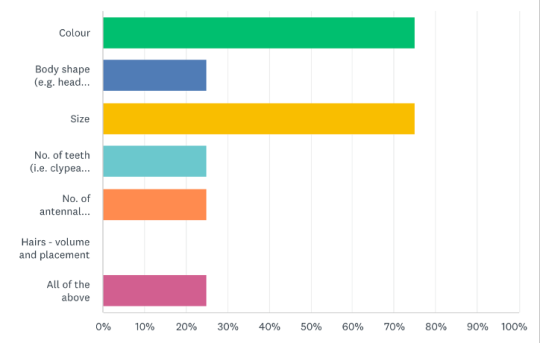
Client feedback session
Key outcomes of meeting with my client RK this week over Zoom were confirming the modelling approach I had selected to move forward with, confirming the plan for the next stage and analysing the results of the survey. It was agreed that we had sufficient information at this stage to move forward with and all survey respondents had advised they would be happy to be contacted for further information or review of the model in future. We touched on a communication plan for the next part of the modelling phase and points at which I may need to check in for advice.
This next week will be focussed on adding the additional elements to the head of the RIFA and further refining the shape.
0 notes
Text
Making It Workshop #1 (14/4/23)
During this workshop, I finalized my two independent projects. Project A will be the PleinAirpril challenge and Project B will be a visual development project.

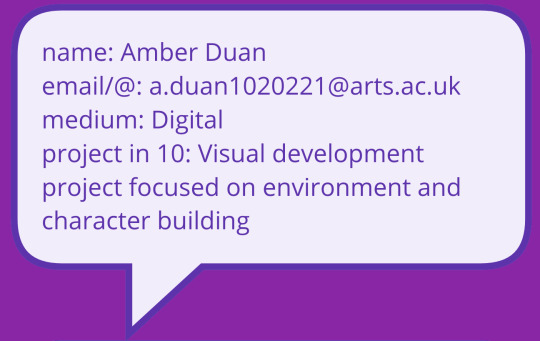

I chose Identities and Place for Project A since I'm primarily focusing on documenting environments and places. I want to express a sense of character and personality in the spaces I paint. The resource I put in the Miro board was a link to Monica Nguyen-Vo's portfolio tab of background art.
I follow Monica on Twitter and I know that for a period of time, she would do daily background paintings for a 30 minute duration. I really like the quality of her environment art, specifically her shape language and color palettes.

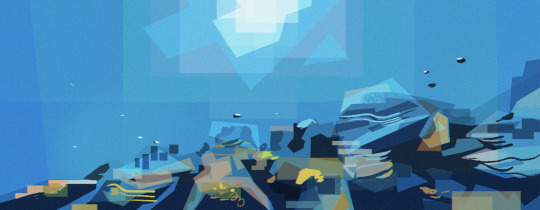
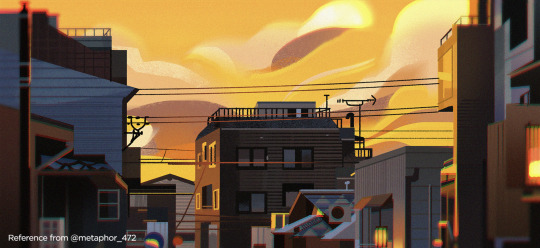
I adore the stylized geometric look of her shapes, and the way they still clearly communicate the details of the environments in spite of the liberties she's taken. The way some forms are broken up remind me of low-poly 3d models, where the surfaces are composed of a very limited number of faces and vertices. I've always found low-poly art to be charming, so I really appreciate the influence in 2d illustration as well.
The light sources in these paintings are well portrayed, showing where the light is coming from and what kind of light it is. The sun depicted in the underwater piece is especially cool since it shows how the light would be refracted through the water.
I look up to Monica's art a lot since she's a relatively recent graduate, and has already worked for multiple animation studios such as Netflix, Cartoon Network, and Nickelodeon.
I chose to place my Project B under Sequences and Time since it's a visual development project geared towards animation. I think it would also work as a comic project though, which is also a sequence based visual media.
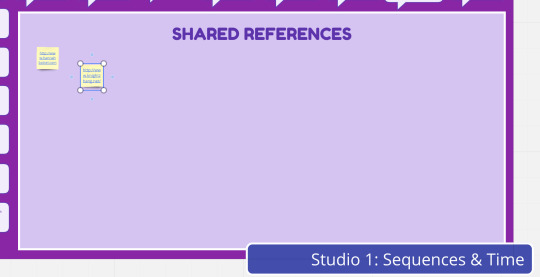
I shared Knight Zhang's portfolio website for the Miro board because she's a very experienced visual development artist.
I like referencing Knight's portfolio because her website showcases a mix of more polished work and more exploratory sketches. She has very tight character turnarounds and pose references, but also initial character designs and even brainstorming notes.

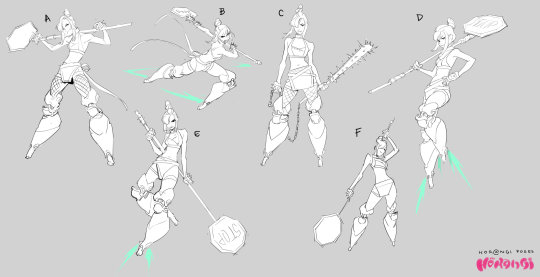
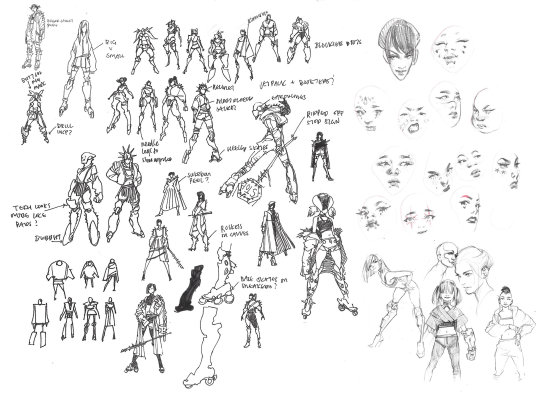
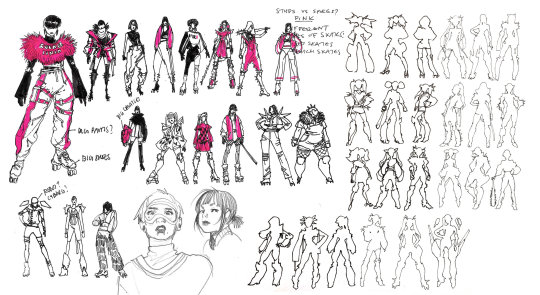
Knight's work is more video game oriented but I still think it's a good reference for visual development work in general, and I'll definitely be looking back at it while creating my own visdev project.
0 notes
Text
Animation
Animation is the process of stitching together frames or images, whether digital or physical, at such a speed as to give the impression of movement. Animation can be stylised, such as the slightly lower frame rate of animes compared to western animations, or through iconic and unique methods such as claymation/stop-motion, or [more recently] use of 3d outlines in 3d digital animation [Puss In Boots II, Spiderverse, etc].
The powers that be have requested I compare 5 games with 5 pieces of media. My games will be Celeste [obviously], Team Fortress 2, Cuphead, Ultrakill and Slime Rancher and my media Puss In Boots II, Love Death And Robots [well, episodes of it], JoJo's Bizarre Adventure Pt.5 [I had to and I will not apologise], Gravity Falls and Wallace and Grommet [luv me Wallace and Grommet, luv me Aardman, 'ate Disney. Not an anima'or, just don't like em. Simple as]
Celeste

Celeste animates in pixel art, with very "bouncy" characters, hazards and environment [dependent on location]. The steady background movement helps keep the environment feeling alive and reactive, if not to the player. Each area in Celeste has a different palette and animation stiffness which gives them a unique visual identity through their animation.
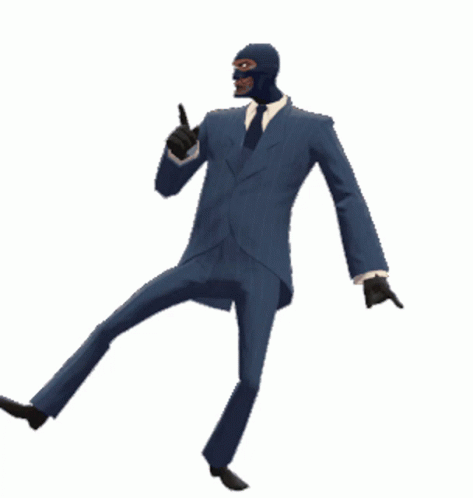
TF2 animates in a slightly geometric and blocky 3D style. The character's [here, Spy's] shape is extremely recognisable due to its geometric composition, particularly in comparison to the other characters. Unlike in Celeste, the environment doesn't move in response to the players, however the game feels alive due to the chaotic nature of the game and the slightly goofy animation style. This style is likely a product of manual animation due to TF2 being from 2007, prior to the technique of motion-capture.

Ultrakill is the closest to an acid trip that one can legally get. It is also one of the video games ever made. The character models are relatively low-poly and the animation , although not extremely smooth, is serviceable in isolation and works well with the artstyle. The speed [or lack thereof] is slightly reminiscent of anime and its portrayal of characters also reflects this. I will talk more about anime later unfortunately.
0 notes
Text
A New Composition of High Heat General Purpose Polystyrene (High Heat GPPS) Resin
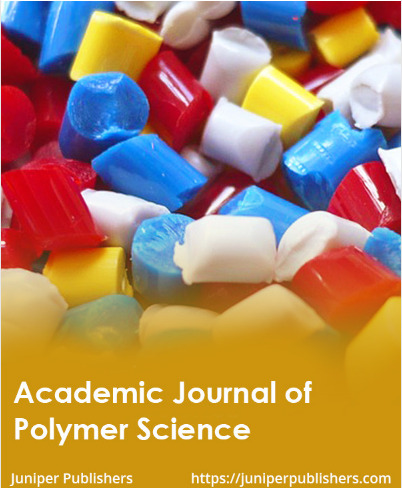
Abstract
A new composition of high heat general-purpose polystyrene (High heat GPPS) resin synthesis is discussed. The new composition of resin involves addition of cross-linker/comonomer in very low concentration during synthesis process. Commercially available vinyl cross-linkers like divinylbenzene (DVB), Ethylene dimethacrylate (EDM), Tricycle (5.2.1.02,6) decanedimethanol diacrylate (TDDDA), Dicyclopentadiene (DCPD) and vinyl comonomer like maleic anhydride, α-methylstyrene have been evaluated via bulk polymerization method. DVB showed enhancement in the heat distortion temperature (HDT), vicat softening temperature (VST) & melt flow index (MFI) compared to the benchmark grade of GPPS, whereas other mechanical and impact properties remained same or better than benchmark grade under identical methods of measurement.
Keywords: Divinylbenzene; Cross-linked; Branching; Polymerization; Heat Distortion Temperature (HDT); Melt Flow Index (MFI)
Abbreviations: HDT: Heat Distortion Temperature; MFI: Melt Flow Index; DVB: Divinylbenzene; EDM: Ethylene Dimethacrylate; TDDDA: Tricycle (5.2.1.02,6) Decanedimethanol Diacrylate; DCPD: Dicyclopentadiene; VST: Vicat Softening Temperature; High Heat GPPS: High Heat General- Purpose Polystyrene
Introduction
Polystyrene (PS) is a multipurpose polymer used in varied applications in rigid and foamed forms. Based on orientation of phenyl group on the polymer backbone, polystyrene can be classified into isotactic, syndiotactic and atactic. Isotactic or syndiotactic polystyrene prepared by metallocene catalyst can give HDT/VST around 250 oC and shows lowest specific gravity compared to any other engineering plastics in the market [1]. XAREC is world’s first syndiotactic polystyrene commercialized by Idemitsu Corporation, used in electronic component molding [2]. The first two are commercially not important due to complexity in the synthesis and processability compared to atactic polystyrene. Atactic polystyrene is known as generalpurpose polystyrene (GPPS). It is produced by simple thermal initiated radical bulk polymerization [3]. GPPS is clear, hard and can be used in packaging, household items, and electronics. The excellent physical and processing properties make GPPS suitable for many applications as compared to any other plastics, but its glass transition temperature (Tg) is only 100 oC that leads to limit its use in certain applications. Tg dictates the continuous service temperature that is a very important factor for polymer to evaluate its processing and application performance. Therefore, there is a demand for high Tg GPPS. Some efforts have been reported in this direction by copolymerizing styrene with maleimide and imide, which act as hydrogen-bond interaction site in the copolymer [4]. Although there is no direct relation between Tg and HDT in polymers, but in amorphous polymer like GPPS, HDT is close to Tg [5].
HDT can be improved by increasing the interaction of chains or by restricting the chain mobility at elevated temperature. Although GPPS synthesis process is well established and matured, the market requirement and customer application always demand to develop new process or improve the efficiency of the process. Vinyl based anhydrides, amides, maleimides and methylstyrenes have been explored as comonomers in different loading to enhance the heat resistance of polystyrene [4-5]. This is generally achieved by introducing heteroatom containing monomer in the polystyrene chain, which leads chemical irregularity or steric hindrance in the polystyrene chain. GPPS has been widely used in food packaging containers, disposable containers, kitchenware & cutleries owing to its excellent transparency, water resistance and colorability. Molded articles prepared by GPPS with lower HDT/VST can undergo structural deformation especially when they are used in hot filled applications and lower HDT can affect the production rate during molding due to the long cycle time. Good thermal properties like higher HDT/VST along with flow are important requirement for the product performance with better heat stability & shorter cycle time in the production line. Therefore, our research was focused in first instant to increase the Tg and HDT/VST, without affecting flow properties.
Experimental Section
Material and Methods
All the chemicals that were used in the process procured from Sigma-Aldrich and used as such.
Gel-permeation chromatography (GPC)
The molecular weight of intermediate samples and final polymer was measured by GPC at 40 oC (Make-Shimadzu, Class-VP). THF was used as mobile and diluent solvent, sample concentration 2 mg/ml, column specification- PLgel 5 μm MIXED-C, 300 x 7.5 mm, Detector- UV @254nm, standards- Monodispersed polystyrene standards.
Differential scanning calorimetry (DSC)
Differential scanning calorimetry (DSC) of the samples was done with TA Instruments/DSC Q 1000 by heating the samples from room temperature to 160 ºC and heating rate always maintained at 10 ºC/min in nitrogen atmosphere.
High performance liquid chromatography (HPLC)
Unreacted residual styrene monomer was detected and quantified by high performance liquid chromatography (HPLC) Agilent HPLC-1260 series. The chromatographic condition are as follows, column- Agilent Zorbax,-C18, (4.6X150mm), 5μ; Mobile phase: Reservoir A -0.02% Orth phosphoric acid in Milli-Q water, Reservoir B-Methanol, Reservoir C - Acetonitrile at different gradients. Flow rate 1 ml/min, detector-diode array detector, wave lenth-254 nm. Column temperatue-40 oC.
Melt flow index (MFI)
Melt flow index was measured at 230 oC & 2.16 kg load as per the ASTM D 1238, in GOTTFERT MFI machine (model-MI-4).
Heat distortion temperature (HDT)
Heat distortion temperature was measured as per the ASTM D648, method B at 0.45 MPa load, on the CEAST machine. All the samples were annealed for 70 hrs. at 70 oC prior to test.
Vicat softening temperature (VST)
Vicat softening temperature was also measured in CEAST machine for annealed samples as per ASTM D1525. All the samples were annealed for 70 hrs. at 70 oC prior to test.
Mechanical property (Tensile and Izod Impact notched)
Injection molded specimens are conditioned for 48 h at 23 oC & relative humidity at 50%. Tensile strength was measured were accordance to ASTM D638, on Zwick 2.5 RTI-UTM machine. Izod impact notched was measured as per the ASTM D256.
Polymerization and Processing
Comonomer/cross linker screening
The following comonomers/cross linkers were screened in 100 g batch scale, the concentration of comonomer was maintained at 0-5 wt. %.
Styrene with comonomer was transferred to the pre-heated (128 oC) glass reactor, the residence time/reaction time and temperature were increased at four different time intervals to make a continuous process. Intermediate samples were collected to monitor molecular weight, Tg and conversions at every 1 h interval. Unreacted styrene monomer or residual monomer was removed by precipitating polymer solution (in THF) in hexane and then measured Tg.
Scale-up (1kg) in lab glass reactor setup
Following three formulation were shortlisted for scale-up in 1kg scale in the lab glass reactor setup (Figure 1 SI) based on the screening experimental results and evaluated thermal, flow & mechanical properties. The reaction conditions were kept as in Table 1. The unreacted styrene was removed by applying high vacuum (0-30 mbar) for 10-12 min at the end of the polymerization.
a. High molecular weight GPPS (Mw > 300 kg mol-1)
b. Evaluation of cross linker DVB at 100 ppm loading
c. Evaluation of comonomer MA at 5 wt. % loading
GPPS process and compounding
To evaluate the final properties of the synthesized polystyrene and copolymers were processed in different steps as shown in the Figure 1.
Results and Discussion
Different approaches to develop high heat GPPS
Based on literature search and our expertise three different approaches had been identified to achieve the targeted properties (CTQ’s).
a. High molecular weight GPPS (Mw > 300 kg mol-1)
b. Evaluation of cross linkers & comonomers
High molecular weight GPPS (Mw >300 kg mol-1)
This approach is simple and straightforward; this has been achieved by optimizing reaction time and temperature of the synthesis process as shown in the Table 2. In general, polystyrene molecular weight (Mw) can grow up to 340-350 kg mol-1 in radical bulk polymerization technique at 3-3.5 h reaction time (pre-poly), but later decreased due to thermal degradation and long residential time. In order to achieve Mw ≥300 kg mol-1, the polymerization was stopped after 4 h reaction time, with ~ 80 % conversion. At final stage high vacuum was applied for 10 min to remove 17-18 % unreacted styrene, after double extrusion the final residual was 1500 ppm.
From Table 3, MFI data shows that as molecular weight increased the flow decreased, but HDT and VST increased by 2 oC. Other mechanical properties like impact and tensile properties are better or equal to the baseline material PS160. Due to the low MFI, high molecular weight approach may have negative effect on processability and cycle time during molding. Figure 2, the GPC chromatograms shows that decreased molecular weight due to thermal degradation at different stages of processing.
Evaluation of cross linkers & comonomers
Following cross linkers and comonomers were screened at different loading for high heat GPPS (Table 4) at 100 g scale. All the cross linkers were screened in the range of 50-500 ppm to avoid gelling in the reactor, whereas comonomers were tested in 1-5 wt. % loading. DVB was shortlisted for scale-up in 1kg scale and evaluated for thermal and mechanical properties as it showed better Tg (107 oC, when residual styrene ~100 ppm). Moreover, it is commercially available in bulk quantities, FDA approved and reactivity is almost similar to the styrene monomer [6-7]. The same formulation was scaled up to 5 kg scale in batch reactor in similar reaction conditions. Tricyclo (5.2.1.02,6) decane dimethanol diacrylate and N,N-Hexamethylenebis (methacrylamide) as crosslinkers did not show any improvement in Tg in the final polymer. MA showed best Tg among comonomers at 4-5 wt. % loading and was scaled up to 1 kg in lab scale. DVB loading was optimized to 100 ppm, higher loading showed low MFI (< 3.0 g/10 min) because of high molecular weight and more crosslinking. Intermediate sample analysis showed that molecular weight increased up to 3rd hour and then started decreasing (Figure 3). This is may be due to thermal degradation under dynamic reaction conditions. Styrene-DVB copolymer always gave broader PDI (≥3.0) due to partial crosslinking or chain extension/branching, which leads to higher MFI. The chain extension was envisaged by lower slope/slower relaxation in the lower frequency region in rotational rheometer study as shown in Figure 4.
Solid content and viscosity at prepoly stage was almost similar to the homopolymer (Table 5). From Figure 7 it is very clear that residual styrene can affect Tg, that is higher the residual, lower the Tg, hence HDT/VST can also change accordingly (Table 6). It is required to maintain optimum level of (< 500 ppm, more preferably < 200 ppm as in example 2) residual in the final polymer to hit HDT > 102 oC or VST >106 oC as showed in table 6, example 2-4. The mechanical properties as if tensile strength & impact were better than the baseline PS160 (Table 6). There is no change in the thermal stability of styrene-DVB copolymer at 100 ppm DVB loading in compared to baseline GPPS PS160 (Figure 2 SI). Comonomers were evaluated in 1-5wt.% loading along with styrene, under similar reaction conditions as mentioned in the Table 2. Maleic anhydride (MA) showed HDT-102 oC, and MFI ~ 10-12 at 5 wt. % loading, but imparts haziness to the final polymer and more brittle than baseline PS 160. MA cannot homopolymerize, however in the presence of styrene it always forms alternative copolymer. This is may be due to higher activity of MA (0.02 time higher than styrene) [8].
Since, we are restricted ourselves to MA content to 5 wt. % maximum in the formulation, MA was added slowly over 1 h time in the prepoly stage and anticipated fair distribution throughout the chain. As MA content increased in the formulation the copolymer molecular weight decreased below critical molecular weight (~240 kg mol-1) as showed in the Table 7 & Figure 9. As 5 wt. % loading showed Tg~ 108 oC (Figure 10), the same was scaled up to 1kg in the lab reactor and evaluated for the mechanical and thermal properties. In styrene-MA copolymerization, the propagating chains were styrinic in nature because the maleic anhydride radicals undergo chain transfer reaction in this highly reactive system [9]. The styrene-MA system was highly exothermic compared to styrene homopolymerization and styrene-DVB system. This is because hydrogen abstraction from the maleic anhydride radical is 40 kJ/ mol more exothermic than that of styrene radical. This finally leads to inferior mechanical properties compared to the baseline as shown in the Table 7. Other comonomers like alpha-methylstyrene and DCPD did not show considerable improvement in thermal or flow properties up to 5 wt. % loading.
Conclusion
Divinylbenzene (DVB) as a crossliker at 100 ppm loading showed balance of thermal and flow properties as compared to baseline PS160. The controlled crosslinking of polystyrene chains by DVB play major role in broad distribution of molecular weight and hence better flow (MFI). There is an increment in the HDT/ VST by 2-3 oC and MFI from 3.3 g/10 min to 7 g/10 min without compromising any other properties of GPPS.
For more Open Access Journals in Juniper Publishers please click on: https://juniperpublishersblog.wordpress.com/
For more articles in Academic Journal of Polymer Science please click on: https://juniperpublishers.com/ajop/index.php
2 notes
·
View notes
Text
RocketBook Flip - a rare review and it’s not a game!
Before I go any further, I feel I must point out that I don’t have any financial connection to RocketBook whatsoever – this isn’t a piece that was requested or courted by RocketBook or affiliates and I’m not receiving any reward or sponsorship either in product or direct payment for this article. I just like the damn thing and love it when an innovative piece of tech (in this case quite low key) just works.
Hi I’m Paul, and I have a bit of a problem with notebooks – A4 lined, sketch, reporters, Black & Reds (ohhhh the sheer number of B&Rs), goofy ones, serious work ones, battered ones, pristine ‘for best only’ ones – and they all fill at an alarming rate. I make notes on everything. Working as a sound engineer and designer, there’s always mix notes, soundscape plots, ideas, VO notes and scripts, SFX ideas etc etc. At home it’s a very different story – it’s much worse. Game notes; blog notes; hurriedly scribbled quiz questions spurred by watching another episode of Mental Floss’ 500 facts about cheese; RPG notes and story ideas; my own script writing; world building; sketches; other creative ideas; song/music notes and ideas; and that’s before we get to to-do lists; and the dreaded ‘things I must remember’.
So my journal life is many, varied and plenty. The usual issue is… ‘what frakking journal did I put that amazing idea in????’, and that’s way before we get to the utter horror that is possibly losing a whole journal or forgetting to bring one home from work. I’m 53, I forget more than I recall, and journals help bring some semblance of order to a massively chaotic and fertile brain. What I’ve needed for a long time is some way of organising all this info or centralising it in some way.
Sure I’ve looked at apps – I used Things, Evernote, Notes, and One Note for years, and they are really, really good, but they relied on either having a charged device exactly when I need it (yeah – me too) or net access, which for a new-ish theatre, is surprisingly a bit of an issue at work. And the most important part – I actually enjoy the physical act of handwriting long-hand. I still write actual physical letters to people, it’s adorable and a bit creepy in this age, but I call it charming and leave it at that. Handwriting, for me, allows me time to think and process in a way that typing just doesn’t. Handwriting is slower, I rarely cross anything out, and so I always have the whole of the thought.
So what I’ve ideally wanted for years, was a reliable way of organising all my notes and storing them electronically so I have access even without the actual journal, with OCR so they’re editable, and still being a tactile handwritten experience.
I’m naturally a sceptic (I actually subscribe to Fortean Times – yeah – I card carry!) and so online ads and particularly FaceAche ads are a field day for critical thinking triggers. I don’t think I’ve ever received from Wish, exactly what I ordered from Wish. And so when an ad from RocketBook constantly kept popping up on my timeline a few weeks ago, I was naturally “it’ll never work”
But their website looked legit enough – they had a dedicated UK shop, it was relatively steep to buy in but not so wild that if it didn’t work I wouldn’t be crying too much about the money wasted, and at the end of the day it was a 10th the price of a ReMarkable 2 which is actually what I thought would solve my problem. I’m furloughed at the mo and though I could argue the case for £300+ notebook (test me, I could), I just couldn’t justify it now. And RocketBook had a good summer intro offer.
I ordered on the Wednesday, and the impressively glitzy and graphic-design-playbook poly package was dropped on my doorstep just 2 days later by my cheery postie who yelled up the drive “Package for ya, looks very exciting!!!!” I like that our postal service is still invested in the hopes and dreams of their customers. It was exciting. All the instructions for getting started with my new Teal RocketBook A4 Flip were right there before you even open it. The main body houses the pad and a cleaning cloth, and a clever little side pocket houses the supplied Pilot Frixion pen.

RocketBooks come in several models, all configured slightly differently. I have the Flip which is a top spiral-bound softback pad with 21 double sided ‘pages’ giving 42 pages in total. The Flip has lined paper one side, and dot paper on the reverse (great for D&D maps, impromptu tables, mixer channel plots etc)
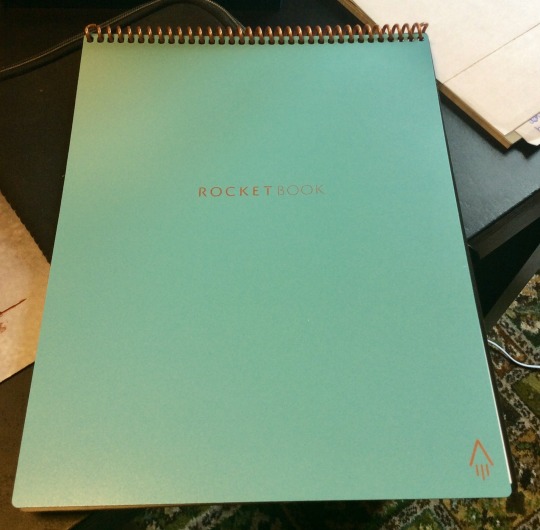
DELIVERY & FIRST IMPRESSIONS
The pads are nicely made, with sturdy covers (available in some really nice colours too) and a solid, thick plastic ring binding. Initially, The RocketBook does feel a bit odd. Its ‘pages’ are actually a synthetic polyester blend and feel quite shiny to the touch. The sort of surface you just instantly feel is not going to be great for ink! Each page is edge-to-edge lined or dotted with a heavy black border. At the bottom is a prominent QR code used for scanning and some very feint icons. These 7 icons are the key to the ease of use of the RocketBook series. But more later.
THE APP
The pads work with a companion app, that is absolutely free and available for Apple & Android. In fact, RB even do downloadable printable pages so you can try the whole system absolutely free before you buy – I didn’t, I just bought one, y’know. The app allows you to set up your destination locations, your preferences and does the actual scanning. Just one quick note, I have the app on both my phone and iPad and had to set-up the app the same for both, there appears to be no way of swapping preference settings between devices, though I can see why this may be intentional.
Currently, the RocketBook allows you to choose from the following locations to send files to: GoogleDrive, box, EverNote, DropBox, slack, OneNote, iCloud, OneDrive as well as simply to an email (or multiple) addresses and iMessage. Impressively, these are not fixed either, so you could choose your 7 destinations to be 7 email addresses of team members. These 7 locations are the icons at the bottom of each page. To select a destination for your file, you just make a mark in that icon box (tick, circle, something unsavoury) and that page will be sent to whichever you select. This makes the system very flexible indeed as not every page is necessarily sent to every destination. You always decide every time you fill a page. Change your mind on a second revision? No problem, add or change icons at any time and re-upload.
There’s a really handy table on the inside front cover for you to note what icon sends what where. This is also wipeable, so can be changed anytime.
I have mine set by default to:
Rocket > main email address (either as PDF, JPG, OCR embedded or as separate txt file)
Diamond > GoogleDrive (you can specify exactly what folder too)
Apple > iMessage
Bell > OneNote
That actually still leaves me 3 spare: shamrock; star; and horseshoe.
The app took me maybe 20mins to set-up, that included decision time for destinations and setting up a few target folders. It also included a few ‘test firings’. I didn’t get everything right first time and a few things didn’t send, but crucially, a tiny bit of digging revealed very simple troubleshooting (including the aforementioned issue with no sync’ing of phone and iPad), and all in I was finding the files in all the right destinations within about 30 mins. The website, FAQs and community are immensely helpful with any other issues as well. I had a tiny issue with OneNote seeming to take ages to sync, but I think that’s an issue with my OneNote settings, everything else was almost instantaneous. You can also handily set the app to auto-send as soon as it scans, or allow for manual review.

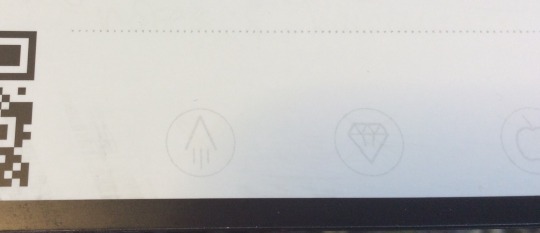
CLEAN UP ON AISLE ROCKETPAD
The main reason I wanted to look at the RocketBook was the issue of reusability. My journal shenanigans are by no means the biggest ecological disaster on the planet, but if we are to believe Tesco (who probably issue as many receipts at our local Tesco Express in a day as journals I’ve ever used), every little helps. If I could find an ecologically better solution, I should at least take a look.
The RocketPads work by partnering with Pilot pens called Frixion. The really clever bit is RB’s paper technology and how it works with the Frixion ink. At present, the pads only work with the Frixion pens – except the RB Colour which works with Crayola’s dry-erase crayons.
When you write on the ‘paper’ with a Frixion pen, it remains wet for a few seconds and then dries pretty quickly. There’s no smudging whatsoever in transit, which is pretty cool. From then on, it may as well be permanent, until you have transmitted your page and decide you don’t want the text anymore. To wipe the page clean, you can dampen the supplied cloth and just wipe the surface clean, it’s weird but it works! But then damp cloth in your bag? So I use kitchen roll to dampen, then wipe dry with theirs. Others even have an adorably kitsch spray bottle in their kit.
RB reckon if you are not going to use the pad for a few months, to clean the pages as the ink can get trickier to shift after a long time, but for day-to-day use, I’ve tried writing and wiping well over 20x and the page hasn’t become discoloured or tarnished at all.
The only pad different in the range is the Wave which cleans by microwaving! Do NOT do this with any of the others, bad things will happen. The ink doesn’t take scrubbing or any time to come up, I clean my pages in about 10-15s. The page can feel a little tacky when it’s damp, but leave a minute or so and the page will be back to normal.
RB do say that odd things can happen if the book is left near a heatsource or in a hot car, vis-à-vis, the ink can completely disappear horrifyingly enough. They say that putting the pen or the pad in the freezer for a little while will actually restore the ink, but I’ve not tried it yet so can’t confirm or deny how that goes. Handy for spies in hot countries though, so there’s another target market.
If you are always going to send your pages to the same places, then don’t erase the marked icons, and the page is ready for new notes straight away, otherwise, scrub them too.
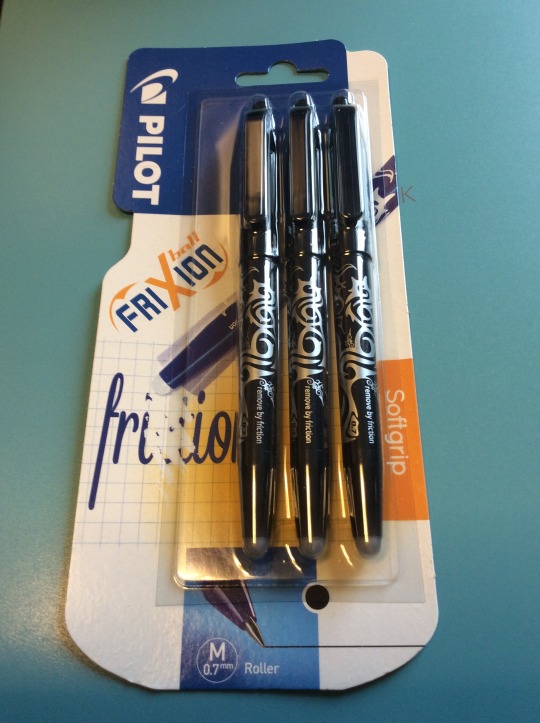
I CAN’T READ YOUR WRITING – ARE YOU A DOCTOR?
Initially, the RB pads send their files as scans of the pages in high contrast monochrome (colour is available) when you snap the page in the app (which auto-frames for you and takes maybe 10s to capture). The formats are either as images or PDF.
If that had been it, I would have been quite happy, but the RB pads have another trick up their sleeve. Firstly, they have a function called ‘Smart Titles’ which allows you to name your files directly from the page by writing a filename between double hashtags ie ## this is my scrawl 24/8/20 ## and the file will pop up in your destinations with the filename “this is my scrawl 24/08/20” – this is insanely handy – there’s no protocol except your own and the hashtags, and it makes your files super easy to search. You can even send groups of pages as a single PDF.
But the notebooks go even further. They actually offer full searchable OCR which the app can be set to send embedded in the PDF or image, or more usefully, as a companion separate .txt file. Now, my handwriting isn’t the neatest, but it’s not bad so I was prepared for some editing to be necessary, but impressively again, the OCR was about 90-95% accurate. In a page of text it missed maybe 3 or 4 words and even those not badly. This is all considering their full OCR is still only in beta! It gets confused with diagrams on the page, but that’s to be expected.
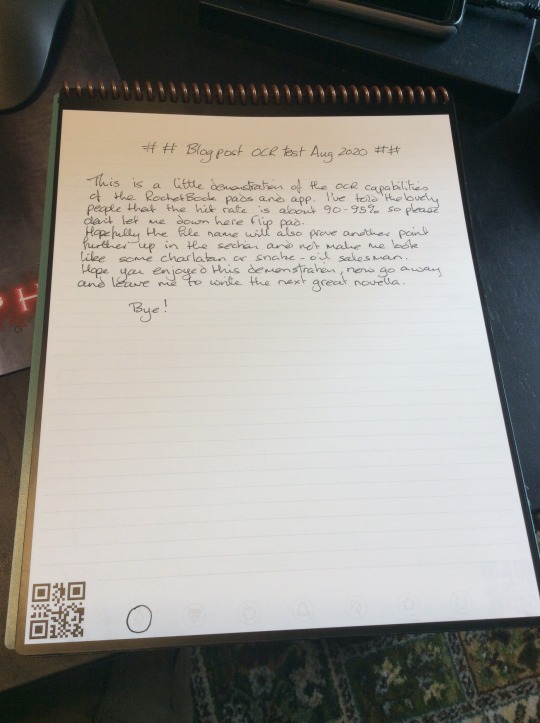

Text Generated by OCR:
## Blog post och test Aug 2020 ##
This is a little demonstration of the OCR capabilities of the Rocket Book pads and app. I've told the lovely people that the hit rate is about 90-95% so please dant let me down here flip pad. Hopefully the file name will also prove another point further up in the section and not make me look like some charlatan or snake-oil salesman.Hope you enjoyed this demonstrahen, now go away and leave me to write the next great novella.Bye!
HOW MUCH?
On average, I pay anywhere from £4-8 for a decent A4 notebook/journal, so at £30-37 (dependent on model), the RocketBook pads are not a whim purchase. That said, I get through a lot of journals in a year, and given that I would expect to easily get 2-3 years out of a RocketBook pad, then I’ve saved money. Will it replace all my notebooks? No. You need to be thinking of carrying this round as a kit: pad, Frixion pen (at least 2), and cloth. RB do a series of portfolio sleeves for the pads but it does push the price up a bit still, but for a rep, engineer or salesperson, this still makes sense. They’re less bulky than a normal A4 pad too.
What I would say is Tesco and Sainsbury’s currently stock Frixion pens and at much better prices than buying them from RB directly, I just paid £3 for 3 pens on offer at Tesco compared to £10 from RB. You get one pen with the pad, but you’re going to want more soon, so stock up next time you’re shopping for truffle oil crisps.
If you use whiteboards a lot, RB also have you covered. Instead of the pad, £16 will get you a 4 pack of ‘beacons’ – little self-adhesive triangles that effectively do the same thing as the QR code in the pad. You don’t have the icon options obviously, but if you’re looking to distribute quick meeting or group notes, this would be a boon.
CONCLUSION
Considering this was a fairly speculative purchase on my part, my early experiences with the RocketBook Flip have been really impressive. The flexibility, the ability to store every page in a different location if you really wanted to make it fantastic for organising my notes, which can save me hours of finding the right ^^$&^$&$ notebook in the first place, then scouring that for the one paragraph I was looking for etc etc. The searchable text facility, in-app history for re-sending etc and last but no way least, functional handwriting OCR, makes the RocketBook not only novel, but actually useable!
Would I buy another? As a second notebook – yes. I look forward to seeing what the actual longevity of the product is once I come off furlough and start cramming my day bag with all my junk and a notepad again, but yes, I’d probably just have one at home, and one for work, but make the last 5 mins of each day, scanning and sending work notes so I have them with me wherever.
Impressively, the RocketBook Flip just works and it works well. ‘Er Across The Table has already sold several folk at her work on the idea and she doesn’t even have one herself yet! I love it. It’s taking a little adjusting to, but it’s all good. The most important thing though is the writing experience, and I have to say, the combination of the Frixion pen/ink and the polymer technology of the Flip, again, just works. It’s smooth, doesn’t skip or smudge for me (I know some right to left users and left handers have reported some issues) and feels great to write on. If anything I have to slow down a bit as the contact is so smooth that your writing can get a bit ahead of you!
RocketBook have produced a cracker of a product. It might not seem like much, but if practical working journals are your thing (ie not create and keep things) then I can highly recommend the RocketBook series.
2 notes
·
View notes
Text
Sonic 3D Blast - 1996 Sega Genesis/Sega Saturn Retrospective
youtube
After Sonic & Knuckles launched in 1994, the original Sonic Team decided to hang up the towel on Sonic for a while. Sonic Team leader Yuji Naka wanted to return to Japan and explore new ideas for the Sega Saturn, but Sega still wanted more Sonic games. While Naka and Sonic Team worked on what would become NiGHTs into Dreams, Sega put plans into action for new Sonic titles for all of their consoles.
Sega’s in-house studio Sega Technical Institute, which was responsible for previous main line Sonic games and spin-offs, would handle Sonic X-Treme for the Sega Saturn. Traveller’s Tales, a British studio, were hired to produce an isometric Sonic game for the Sega Genesis to be released alongside X-Treme. When Sonic X-Treme was cancelled late in the game, Sega asked Traveller’s Tales to port 3D Blast to the Sega Saturn. What was supposed to be a spin-off game now graduated to a main Holiday release for Sega.
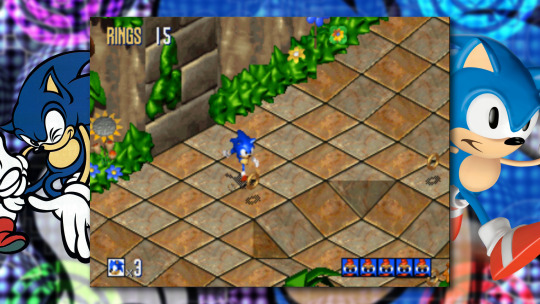
Sonic 3D Blast was released for the Sega Genesis in November 1996, with the Saturn version following in early 1997. The game was released exclusively in North America and Europe, until 1999 when the Saturn version was released in Japan alongside the International version of Sonic Adventure for Dreamcast. The game was promoted with a Christmas special called Sonic Christmas Blast, which was originally meant to promote Sonic X-Treme and was called “An X-Tremely Sonic Christmas” originally.
For the most part the Genesis and Saturn versions are the same game with the same levels. The first thing you’ll notice is that the Saturn version has a bigger CGI opening scene, as well as higher resolution graphics. The game’s art style was made in the same pre-rendered computer graphics that brought Donkey Kong Country to life. The Sega Saturn allows for more detailed character graphics and backgrounds, as well as weather effects.
Of course the Saturn version is fondly remembered for it’s Special Stage, a 3D recreation of the half-pipe from Sonic 2 with low-poly models of Sonic, Tails, and Knuckles. This would be the first time Sonic would appear as a full 3D model instead of as a pre-rendered 3D image. These stages were developed by Sonic Team in Japan, lending a hand in the last minute shuffle after X-Treme’s cancellation.

The game puts a psuedo-3D pre-rendered Sonic into pseudo-3D isometric stages. Why do I say pseudo? Because the game isn’t actually in 3D. The game’s marketing emphasized the pre-rendered graphics and isometric play field relative to the 2D side-scrolling perspective of earlier games. 3D Blast was also up against Super Mario 64, so Sega was selling the idea to parents that a Super Mario 64 sized adventure was possible on older hardware. This, of course, isn’t exactly true.
Sega had a big presence at E3 1996 where they had their 3 major Sonic titles for the Holiday season on display. Sonic X-Treme for the Saturn, and Sonic Blast for the Sega Genesis and Game Gear. At this point they weren’t using the term 3D, and they were marketing both games with the same title. The Game Gear game Sonic Blast is largely unrelated from Sonic 3D Blast, as all Game Gear games that share a title with a Genesis game tend to be.
Sonic 3D Blast feels like a Sonic game from a different perspective, except instead of running through a stage and reaching a designated goal now Sonic has to collect Flickies and deliver them to a Goal Ring in the area. Each Flicky is contained within one of Robotnik’s robots, so Sonic has to destroy all the robots and lead all the Flickies to the goal. This is the sole focus of the game, and a major source of frustration for players.

When you release a Flicky it’ll follow you, and is then susceptible to the same dangers you are. If Sonic gets attacked the Flickies scatter in different directions, often going into areas Sonic can’t normally reach like in the Volcano stage. This combined with the game’s slippery controls make precise movement difficult, thus leaving the player open to mistakes. While there’s a degree of challenge to the game, most of the obstacles are more frustrating than difficult.
In 2017 Jon Burton, lead programmer for Sonic 3D Blast, released a free patch for the Genesis version of the game that fixes the game’s slippery controls, as well as adding a password save system, a time attack mode, and Super Sonic as a playable transformation. Burton made this update in his spare time, calling it a Director’s Cut. This marked the first time a Sonic game had a semi-official ROM hack from one of it’s original developers.
Sonic 3D Blast marked a low point in Sonic history, being the only mainline game released between Sonic & Knuckles in 1994 and Sonic Adventure in 1998. Even though it wasn’t intended to be a main series game, it was still marketed as such so for the purposes of this essay I’ll refer to it as one. I think if Sonic X-Treme had been released, 3D Blast would’ve been held in higher regard.
Support Y2K FunZone on Patreon

#Sonic#Sonic the Hedgehog#Sonic 3D Blast#Sonic 3D Flickies Island#Sonic 3D#Sega#Sega Saturn#Sega Genesis#Sega Mega Drive#Every Sonic Ever
2 notes
·
View notes
Text
Detroit
Can robots feel? To empathize? To do? Despite years of research, scientists do not give clear answers. And where science is powerless, fiction comes to the fore. Last year, with the help of NieR: Automata, Taro Yoko tried to get to the truth. Now David cage, the author of the interactive thrillers Heavy Rain and Beyond: Two Souls, has decided to present his view on the problems of artificial intelligence. Well, guys, myltso?
On the blade
Near future. Technology has made another leap, and the achievements of Boston Dynamics are in the past: androids are already among us, their appearance and behavior are barely distinguishable from ordinary people. Indispensable helpers and cheap slaves in one person, the" children " of CyberLife have been performing the most thankless work for years, bearing the humiliation of the Almighty masters. But nothing lasts forever: suddenly, in Detroit, one after another, deviants begin to appear-machines that have gained self-awareness.
Detroit: Become Human
In a matter of months, humanity is on the verge of war with its greatest creation. Now, in the darkest hour, the fate of the world depends on the actions of ordinary robots, not people. Marcus, the old artist's Butler, is stranded on the street in an accident. Connor, a police officer, hunts for "broken" brothers and tries to find out the reason for their madness. Kara, the housekeeper, runs off with her owner's daughter when he raises his hand to his own child. Heroes are waiting for incredible adventures, and their paths will cross more than once. And who knows how their amazing story will end?
Light, camera, shame
Video games have long been made with an eye on Hollywood. Game designers spy on the Directors ' techniques, more and more screensavers from year to year, and the traditional gameplay is regularly replaced with spectacular QTE. It seems as if developers want to" shoot " movies, rather than sculpt conveyor blockbusters. Only a few people have the courage to say this openly. Few people except David cage and his Studio Quantic Dream.
Detroit: Become Human
Unlike other famous teams, the French company has long ceased to disguise itself: since 2005, it has been exclusively engaged in interactive cinema, where there is no place for shootings with terrorists, boss fights, or other distracting nonsense from the narrative. Cage's logic is impeccable: the industry is already littered with shooters like Call of Duty, why not do something original? But to create such masterpieces, you need skill. Talent. And here's the problem: the Frenchman has nothing else but naked enthusiasm.
Omikron: the Nomad Soul, Fahrenheit, Heavy Rain, Beyond: Two Souls... Each of his opus is a story about how a good idea was ruined by a bad performance. Whatever the game, it's a beautiful dummy-fascinating at first, and then, closer to the final, falling apart. So it was hard to expect anything good from Detroit: Become Human (with its banal beginning). And all the same old cage I found something to surprise.
Detroit: Become Human
Double
Detroit is an emphatically cinematic adventure that tells the fates of several characters at once. As before, the player is required to do relatively little: walk around locations, collect or view garbage, talk a lot, pass sophisticated QTE and survive. Yes, unlike many of the genre's peers, in Become Human (as in the ever-memorable Heavy Rain), the characters can die, and the plot will move on quietly — though, already in the direction of a bad ending. This is not a peaceful LucasArts quest.
Already from the introductory chapters, the new product is perceived as one big work on mistakes — as if all these years the authors studied reviews of their creations, threw out unsuccessful elements and kept working. The output turned out to be a kind of collection of "the best of". Check the boxes: a futuristic world a La Omikron (alas, without David Bowie), an intriguing Fahrenheit introduction with dozens of scenarios, investigative episodes, the death of the protagonists and elements of the heavy Rain interface, Hollywood actors just like in Beyond. Even the main menu resembles the beginning of the Nomad Soul — only instead of a low-poly model, a beautiful girl breaks the fourth wall. Try not to blush.
Detroit: Become Human
And it seems that everything is familiar, familiar, but there is nothing to swear at: from the point of view of game design, the game is made wisely. Even the usual genre flaws here, in the new context, do not look so scary and critical. Do robots speak in an unnatural, UN-human way? Logically, the same pieces of iron! Invisible walls prevent you from exploring locations? Of course, the program does not allow you to deviate from the set course! Bullets don't kill or even slow down characters during action scenes, and wounds heal too quickly? Cars, what to take from them.
However, these are rather pleasant things — the really impressive thing about Detroit: Become Human is something else. Here (unlike the series of some Telltale), the decisions made by the gamer during the "movie" really affect what is happening — very noticeably change the story. At first, the linear narrative branches out over time: unique mini-episodes are opened, even fleeting dialogues and individual chapters vary. And endings are determined not by the choice of a specific scene in the final, but by a number of not always obvious moments. How thoroughly did Connor study the crime scenes? Had Kara managed to escape from her master? And how?
Detroit_ Become Human_20180522213231
Conceptually, the mechanics are similar to the "butterfly effect" Until Dawn (or the earlier Blade Runner from Westwood): do something or say-prepare for the consequences, the authors will not allow the descent. Unless in the Supermassive Games horror movie there were much less variations of the development of events: in this regard, chamber horror is difficult to compete with the cyberpunk epic. Quantic Dream employees have done a lot of work, and they do not hesitate to demonstrate this by drawing giant diagrams at the end of each Chapter, similar to the intricate chronology of some Metal Gear Solid. A good way to mask loading screens!
In other words, in terms of gameplay, the new product really succeeded. Taking the best of their previous creations and borrowing a couple of other people's inventions, the authors finally fulfilled their promise: they released a real interactive movie. Hooray? Hooray. But unfortunately, Detroit is still David cage's "Need more emotion" game. With all the consequences.
Be a man
Alas, in the five years since the premiere of Beyond, the head of Quantic Dream has not learned to write good scripts. Even with the help of new assistants and editors, all he managed to compose was at best a mediocre melodrama about racism, where the roles of oppressed Negroes were assigned to soulless androids. Vulgar metaphors and clumsy references to real historical events (up to the Nazi concentration camps!) attach.
Detroit: Become Human
Admittedly, it's very funny to watch such obvious and artless nonsense in 2018. There are no bright new ideas, unprecedented sci-Fi concepts, or unique views on AI problems. Instead — it is a continuous repetition of what has been studied with a lot of loud words, high-sounding platitudes and obligatory tears in artificial eyes. The characters are all drawn up according to the textbook of archetypes and communicate such Terry platitudes that at times the game borders on self-parody. Sometimes it even seems that Lieutenant Frank Drebin from the Naked gun is about to turn the corner and everything will fall into place. But that would be too subtle. Well, at least there was no nonsense in the spirit of Heavy Rain, that is, attempts to hit and turn what is happening upside down, somehow. Here everything fits into the fragile logic of a fabulous cyberpunk universe, where a robot service can be bought for a measly 899 dollars, and Canada is a futuristic Wonderland.
However, not everything is so sad. There are also good scenes in Detroit — and such that it's not even a shame to watch! They are concentrated mainly in the storyline of Connor (who has to play a buddy movie in the spirit of the series "Almost human"). There is humor, and "chemistry" between two dissimilar partners, and quite a sensible dialogue almost without stupid "snot", from which it is time to roll your eyes. Looking at the amazing adventures of an Android and a grumpy detective Anderson, you keep asking yourself: "why the hell are there two other protagonists in this game?»
1 note
·
View note
Text
A Short Hike - In Depth Analysis and Review SCRIPT
POSTER'S NOTE: This script may have been slightly edited when doing the voice over for the video. Apologies about any inaccuracies.
A Short Hike - Indepth Review
By Count_
Big spoiler warning right off the bat with this video, I do not know how to talk about this game without spoiling either massive parts of what the game is trying to convey to you or what the game wants you to experience. I know this sounds really cheesy but this game works at its absolute best when you know nothing about it aside from the surface level screenshots. If you want a spoiler free overview of what the game is, it’s an open world exploration game that’s essentially a walking simulator. The game contains no real “gameplay” like fighting or difficult platforming, it is a casual experience. And you absolutely should not be going into this game expecting it to be something more than that. My overall opinion for this review is that this game is an absolutely fantastic experience that you should play. The only actual gripe I have with the game is that the price point is going to be a little too high for some people’s standards, especially if you like to get the most mileage out of your money. I would say the best way to legally get ahold of this game would be to subscribe to Humble Monthly and pick this game up from the Humble Trove. You essentially get access to this game for free alongside all of your Humble Monthly games, so getting it through this service is probably the best way to go for most people. Okay that’s all the spoiler free information I can give away, I highly recommend you go play this game before you watch this video because I will be spoiling what the game wants to convey and how the game goes about doing that. This video will not be going anywhere, have fun.
At the core of A Short Hike, the game isn’t even about the hike. The title straight out lies to you. The game begins with a dialogue between the protagonist Claire, and her mother as they drive out towards where Claire, and the player, will be residing for the rest of the game. Claire then appears outside of her cabin amongst a bright and sunny day, where the first character you meet: Ranger, or Aunt May will inquire about why she has been inside all day. To which you, the player, will promptly learn that you’re expecting a phone call, and there’s no service on any part of the island, except for the summit of Hawk Peak. And from there you’ve been given your first quest, get to the summit and get your phone call. Just as a little break off, it is possible to wholly avoid this part of the game by simply diving into the ocean and going the opposite direction. However, assuming you take the natural progression path, when you begin walking down the pathway and receive a small tutorial dialogue on how to glide, you’ll find Jen sitting by the beach. Talking to her provides you another quest: bring back 15 sea shells. Now sea shells aren’t hard to find, you just need to scout out the beaches until you’ve collected enough of them, however there’s a catch and I think you know where this is going. By going out to collect these sea shells you will stumble upon new things to explore and new people to talk to, and those people are also going to give you new quests or tasks to do.
This is the foundation for which the game is built on, because before you know it, in an almost Skyrim-like fashion, you will be far off from the main quest doing all of these different little side gigs. And what started as a short hike, turns into a one to two hour adventure where you do everything else except the hike that you’re told to do. The game even meta-mentions that this would happen by having one of the characters ask Claire if she feels “lost and directionless,” and then give you a compass. There’s two other ways to interpret this off the top of my head: one, is that this is just a joke to introduce the compass, and yeah that’s pretty much it. Or two, which can be tied to the end of the game, so we’ll come back to this. But through these little micro quests, you are actually experiencing the game the way that it’s intended to be played. You run around, meet all these people, do all these tasks for them, go fishing and gliding, and look through binoculars to see if you missed anything below, and this all has a narrative purpose.
You’re never told why you come to this island besides just, “It’s nice to get out of the city.” And you never learn anything about that as you continue playing the game, just that you’re waiting for a phone call. It’s a well wrapped scheme of omission that aims to recontextualize, the entire game. Because when you get to the summit of Hawk Peak, Claire finally gets that phone call, at what couldn’t be a more convenient time. Claire has actually forgotten that this was supposed to happen, and she has a heartfelt conversation with her mother where you learn that her mother has gone through surgery and that she wasn’t told anyone about it until after the fact. It’s never specified when this surgery happened, how Claire found out, or how long she has even been on the island, you just have to assume that she’s been there long enough that people know her name. But that information isn’t important, what’s important is that Claire’s mom probably brought her here to make her forget about the surgery or the worries that encompass it. The player is never told this information because the game wants you to feel the same way Claire does where you can just forget about your worries and have fun. It’s quite obvious how this information is introduced and then very quickly swept under the rug with no impact as you travel the Hawk Peak updraft back to your cabin. You’ll also speak with Aunt May and Claire will tell her that the surgery went okay and that things are fine, and then Claire will recount the experiences that both her and the player have gone through during the game. And that’s where this final interpretation of the line “lost and directionless” comes in because that could be Claire’s mental state in response to the news about the surgery. The hike is a metaphor for getting over worry and you don’t need to know that because it’s not relevant to the player’s overall experience.
That’s where I was primarily impressed with this game, the writing is almost too good for a Humble funded indie project made by one guy with help from a musician. And I’ve dedicated three paragraphs just to talk about the writing and I could write so much more about the animal crossing styled characters and humor, the side stories that these characters have that you can actively follow. On my first playthrough I came across these guys climbing up some play rock walls and I was told to acquire a golden feather and come back, but when you get a golden feather you’re already told how to climb and so I did just that. I climbed around and used my feathers for jumps and forgot about those guys back there. But they actually have dialogue if you come back and climb up these walls, infact through doing this you learn that they’re actually training to climb Hawk Peak and you’ll be able to spot these guys climbing the mountain later on through triggering this dialogue. And there’s so many more examples of this throughout the game like an artist suffering from creative blockage, or someone’s relative wanting you to remind them to hydrate themselves and take breaks. It all makes the world feel really expansive and it’s actually packed so full of content that even though I was pretty thorough in trying to explore and do everything I could, I still missed stuff. I didn’t even get the achievement for collecting all of the golden feathers, and when my girlfriend played she’d tell me about things that I had forgotten about or outright never found and experienced. It’s an exploration sandbox that leads to everyone having their own journey with the game. And that ending? You can complete that as early as you want, the speedrun for this game is 3 minutes and they completely bypass the minimum recommendations that the game gives you. You don’t even have to explore the world outside of just getting enough golden feathers to get to the peak. In a way it’s a game that feels personalized for everyone that plays it.
*ugh* I haven’t even gotten to the gameplay, graphics, or music. The biggest elephant in the room here is the retrograde graphics. Pixel art as an artform is often overdone in indie games because, let’s face the facts, many indie developers are not artists. Well actually Adam is, but we’ll get back to this. There’s something different about the way that the pixel art is incorporated in this game. You can tell because you’re able to swing your camera around in the game and the only way this would be possible is if everything was actually modeled and some form of pixelation was thrown over the visuals. Which means that this art style is entirely deliberate, and actually means something to Adam, the developer. A different art style could’ve been used for this game and still would’ve achieved the same general effect. In fact, the game features a cheat code that completely removes the pixelation, and it looks great! Some of the models are a little scuffed and everything is generally low poly, but with a little bit of polishing this art style could’ve worked. It turns out that this pixelation effect comes from a Unity package called GBCamera which essentially renders the visuals of the game at a small resolution, and has optional bit coloring, classic to the gameboy. At first I thought this was a mere visual effect just put over the game because the Itch.io description isn’t too descriptive on how it actually works. So I decided to ask Adam himself, and I also asked why he decided to use pixel art as the pivotal piece in his art style. And I actually got answers. GBCamera is essentially just a renderer that is capable of rendering in small resolutions that then can be blown up to the resolution of the player’s monitor. For why he used this for his game, he said he simply likes pixel art and that it allows him to make assets faster.
But something caught my attention with the way he worded his response, he thinks the art style is interesting and unique. Now while pixel art in of itself is not at all unique as it’s been pretty common throughout the history of gaming in many different forms, it’s not been quite used in this form before where a fully 3D game is pixelated. The only games that really cross my mind on this is Devil Daggers and DS games. Yeah you heard me right, DS games. The DS, much like A Short Hike, was capable of rendering 3D environments and models, the problem was that the DS had a limited resolution meaning that everything on screen was always very pixelated unless the assets were already based on pixel art. And that, in a way, drove the artistic direction that many DS games took. If things were small, they had to be distinguishable. If things were a fully detailed 3D world, it had to be simplified to avoid being noisy or ugly. The best overall analysis I can give of Adam’s opinion on the style is that he thinks games that are proactively retrograded is unique, and I have to say I agree. It’s a fresh breath of air, and Adam even had the foresight to include an option in the game to select how much the game is pixelated, because it can be an eyesore. My only gripe with this style is that there’s no option just to turn the pixelation off. There’s all of these other options like shadows, color corrections, image quality, etc. but there’s no option to just turn it off. As of the date of this video going up, it has been commented on that Adam has at least thought about adding this option, and if it is in the game by the time this video goes up I’ll leave a little message on the screen. It should also be noted that Adam has used this style in some of his other games, notably You’re Dead in Space and The Night That Speaks so clearly Adam has experience with this art style and he likes it enough to continue using and innovating on it. The somewhat ironic thing here is that You’re Dead in Space is very comparable to Devil Daggers in the sense that they are pixelated hoard shooters where you are expected to eventually die.
Let’s take a couple steps back to when I said that Adam was an artist, and the biggest piece of evidence that I’m going to use for this claim is Adam’s upcoming “Untitled” RPG. Comparing this RPG to Adam’s other games, even A Short Hike, immediately gives off the vibe of, “This was not created by the same person.” But when I sent Adam some questions, one of those asked if Adam was the leading artist for A Short Hike and if he was the lead artist for his upcoming RPG. Basically, he said that yes, he does most of the art assets, most because he does get help from some of his friends. And I just want to point out just how good his upcoming RPG looks. It appears pretty based on Paper Mario but it seems to be adding some more depth to that art style. It looks really good, and so does A Short Hike, and Adam should get the credit that he deserves.
Something else that is really good is the gameplay. Outside of just walking around and jumping, as you progress through the game you will earn the ability to sprint, do multiple mid air jumps, climb, dive, glide, speed glide, and you’ll find special feathers that give you the ability to jump higher and use less stamina while climbing. All of these features make the game feel much like a metroidvania and after you spend a couple hours in the game you’ll be jumping halfway up the map and doing speed glides everywhere you want to go. You’re given all the tools you need right from the beginning and everything you pickup is just upgrades that let you use those tools better. And you’re given a lot of freedom and versatility with those tools. And I would chalk that up to the world design. Everything is very compact and close together, and sometimes just stacked on top of each other in a way that makes traversing the island simple, time efficient, and just exciting. You don’t need to spend five minutes walking in one direction to get to a certain area when everything is pretty much just right next to each other with shortcuts, bounce flowers, and even an updraft to make traversing even easier that will continually get easier as you play the game. An example of this is the, what I’m going to call, Breath of the Wild climb that Claire is suited with. You’re able to climb up any slope or building granted that you have enough feathers left, collecting more feathers or even collecting the silver feathers allows you to climb for longer. The same goes for your jumps, collect more feathers to do more jumps, collect silver feathers to jump higher each time.
Another central piece of Claire’s moveset is her gliding ability and the potential you have for drastically improving how you use it. There’s a hidden island you can travel to that will teach you how to dive into a speed glide, and when you get the technique down you find that the game becomes very open. Your methods of travel will basically revolve around using speed glides to travel the longer distances around the island because it is just that fast. And while we talk about openness and speed, we should talk about speedruns. It’s natural for a game that can be completed at any time to be easy to speedrun, but speedrunners have, naturally, found a way to beat the game with less than the recommended amount of golden feathers. This is because of two methods, one being a bug and the other a feature. The first one is, what I’ll deem, chest jumping where you jump off of a chest while it’s opening animation is playing. And the other is these bouncy flowers that you provide water to in order to unlock shortcuts around the island. Whether intentional or not speedrunners have been able to use these methods to cut the game’s length down to less than three minutes. That might not sound like that incredible of a feat, but it highlights just how many different ways you can play and navigate A Short Hike. If you don’t want to be on your feet for the duration of the game, then you don’t have to. If you want to play the game by finding and doing the least amount of things possible, then you can even if it may defeat the purpose of the game. In these ways A Short Hike is comparable to a sandbox in the way that the game is very open with very little limiting rules or mechanics and in fact promotes the free use of what it provides you. That is what makes the gameplay effective at allowing the player to access the contents of its game.
Finally, I want to address the music, and I’m not a music guy so I can’t provide very complex insight on it, so it’s all going to be pretty basic. And in just one word, the music is good. The soundtrack contains exactly the type of music you’d expect from a game like this, while having a somewhat Celeste-y vibe to it as you progress up the hiking trail. I contacted Mark Sparling, the composer, and asked him some questions about what direction he was given and what his inspirations were. He actually gave a pretty drawn out answer to my questions which I can summarize down to: Adam and Mark discussed what type of music to use and reminisced on similar music that had the same tone such as Animal Crossing, Legend of Zelda, studio Ghibli’s music, as well as music artists and bands such as Sufjan Stevens, Punch Brothers, and Nickel Creek. Mark then produced Beach Buds along with an assortment of different tracks. However Beach Buds ultimately stuck and the rest of the game’s soundtrack fell into place.
The game features a simplistic, yet dynamic music system where certain parts of music tracks or different tracks altogether play in corresponding areas that gives the game a sense of progression. It should be noted that this was Mark’s idea. This system works well in correspondence to how varied the music is and how the music has been produced in the way that one music track holds different “stages” of music. As a system designed to derail players from feeling like the music is too monotonous, it’s pretty good at doing just that despite its simplicity. There wasn’t one time where I thought, “Man I don’t want to listen to this anymore,” over my three playthroughs.
It should also be pointed out that the music is well diversified. It’s a mixture of banjo, chiptune, electronic beats, piano, synth, etc. that’s played in an order throughout the game that is all about something that you don’t understand until you’ve beaten the game. And that’s Claire and the emotional baggage she carries throughout the game as you climb up her personal mountain. Music adds so much to video games, especially ones like this, that people often don’t think about or fully comprehend. And it’s important that the music is done right and it fits the settings and encourages players to be immersed in their experience. Just imagine if the game had no music, or... [rock music] But seriously, I can surely say that the music for A Short Hike does exactly the former, it’s simple yet effective in doing what it needs to do while adding and strengthening the narrative and setting. And while this video isn’t a review for the soundtrack, five dollars nets you the game’s music that comes in long and short versions so that you can listen to either the commercial releases intended for listening audiences or experience the full amount of effort that went into the music.
A Short Hike is a game that tells you everything you need to know right in the title. However it’s a game that’s simultaneously about a short hike while also not being about the hike at all. This is one of those, “It’s not about the destination, it’s about the journey,” kind of games because the way that it’s structured ensures there will be distractions among every step of the way. Whether that’s being asked to find an item, collect a certain amount of feathers, even just being exposed to the beautiful scenery of the game and wanting to see more. A Short Hike is about taking your time to explore and climb a beautiful, lively environment full of inhabitants that might just remind you of certain games you’ve played in the past with retrograde graphics comparable to the DS days. Barring external factors such as pricing, length, distribution platforms, etc. If I had to give a review score for this game, it would easily be, at the lowest, an 8/10. It doesn’t overstay its welcome, and if you’re willing to put $8 down for the game I’d highly recommend purchasing it through Steam or Itch.io.
Thank you for watching.
2 notes
·
View notes
Text
Dr. Sujoy Dasgupta | IVF Doctors in Kolkata | Elawoman
Dr. Sujoy Dasgupta
Dr. Sujoy Dasgupta is a proficient Gynecologist and Infertility master practicing in Garia, Kolkata. He is one of the gifted doctors in Kolkata and is a specialist treating patients suffering from PCOD/PCOS (Poly Ovarian Disease). He spends significant time in Cervical Cerclage, In-Vitro Fertilization(IVF), Intra-Uterine Insemination(IUI), Mirena(Hormonal Iud), Artificial Insemination, Cesarean Section(C Section), Hysterectomy (Abdominal/Vaginal), ICSI, Laparoscopic Surgery, Normal Vaginal Delivery (NVD), Endoscopy and some more.
Dr. Sujoy Dasgupta passed MBBS from Medical College, Kolkata with various Gold Medals, Honors, Silver Medals, grants and grants like Senior Class-Assistant. During his MS from Medical College, Kolkata, he won the Gold Medal for being chosen as the "Best PG Student". He further finished his DNB in Obstetrics and Gynecology from National Board of Education, New Delhi in 2014.
IVF Doctors in Kolkata
In contrast to the less complex procedure of manual semen injection - in which sperm is put in the uterus and origination happens generally regularly - IVF involves combining eggs and sperm outside the body in a research facility. When an embryo or embryos structure, they are then put in the uterus. IVF is a mind-boggling and costly strategy; just about 5% of couples with infertility search it out. Be that as it may, since its introduction in the U.S. in 1981, IVF and other comparable procedures have brought about in excess of 200,000 infants.
What Causes of Infertility Can IVF Treat?
With regards to infertility, IVF might be a choice on the off chance that you or your accomplice have been determined to have:
IVF is never the initial phase in the treatment of infertility aside from in instances of complete tubal blockage. Instead, it's saved for cases in which different techniques, for example, fertility medications, medical procedure, and manual semen injection haven't worked.
In the event that you think that IVF may bode well for you, cautiously survey any treatment focus before undergoing the system. Here are a few things to ask the staff at the fertility clinic:
What is your pregnancy proportion per embryo exchange?
What is your pregnancy rate for couples in our age gathering and with our fertility issue?
What is the live birth rate for all couples who experience this system every year at your office?
What number of those conveyances are twins or other various births?
What amount of will the method cost, including the expense of the hormone medicines?
What amount does it cost to store embryos and to what extent would we be able to store them?
Do you take an interest in an egg gift program?
What Can I Expect From IVF?
The initial phase in IVF Doctors in Kolkata involves injecting hormones so you produce numerous eggs every month instead of just one. You will at that point be tried to determine whether you're prepared for egg recovery.
Preceding the recovery system, you will be given injections of a prescription that matures the developing eggs and begins the procedure of ovulation. Timing is essential; the eggs must be recovered just before they rise up out of the follicles in the ovaries. In the event that the eggs are taken out too soon or past the point of no return, they won't grow ordinarily. Your specialist may do blood tests or an ultrasound to make certain the eggs are at the correct phase of development before retrieving them. The IVF office will furnish you with exceptional instructions to pursue the prior night and the day of the technique. Most ladies are given pain drug and the decision of being gently quieted or going under full anesthesia.
During the methodology, your specialist will find follicles in the ovary with ultrasound and expel the eggs with an empty needle. The system ordinarily takes under 30 minutes, however, may take as long as 60 minutes.
Quickly following the recovery, your eggs will be blended in the research facility with your accomplice's sperm, which he will have given around the same time.
While you and your accomplice return home, the prepared eggs are kept in the clinic under perception to guarantee ideal development. Depending on the clinic, you may even hold as long as five days until the embryo achieves a further developed blastocyst organize.
When the embryos are prepared, you will come back to the IVF office so specialists can exchange at least one into your uterus. This methodology is faster and simpler than the recovery of the egg. The specialist will insert an adaptable cylinder called a catheter through your vagina and cervix and into your uterus, where the embryos will be saved. To increase the odds of pregnancy, most IVF specialists prescribe transferring up to three embryos at any given moment. Nonetheless, this implies you could have various pregnancy, which can increase the wellbeing dangers for both you and the infants.
Following the methodology, you would commonly remain in bed for a few hours and be released four to six hours after the fact. Your specialist will most likely play out a pregnancy test on you around about fourteen days after the embryo exchange.
In situations where the man's sperm tally is incredibly low, specialists may combine IVF with a system called intracytoplasmic sperm injection. In this methodology, a sperm is taken from semen - or sometimes directly from the gonads - and inserted legitimately into the egg. When a practical embryo is delivered, it is exchanged to the uterus using the typical IVF technique.
What Are the Success Rates for IVF?
Achievement rates for IVF rely upon various variables, including the purpose behind infertility, where you're having the strategy done, and your age. The CDC gathers national insights for all helped regenerative innovation (ART) methodology performed in the U.S., including IVF, GIFT, and ZIFT, despite the fact that IVF is by a long shot the most widely recognized; it represents 99% of the techniques. The latest report from 2009 found:
Sanjivani Hospital Kolkata
Sanjivani Hospital Kolkata is a multi-force hospital set up in 2004. It is situated at P 48, Kshirod Vidya Vinod Avenue, Near Girish Manch, Best IVF Clinic in Kolkata. The hospital is known among individuals of North Calcutta for its cutting edge treatment offices at sensible expenses. Since its commencement Sanjeevani hospital has been slowly improving the offices, at present, it is working as a best in class multi-claim to fame hospital with 60 beds, a few divisions and a group of experienced do and the accompanying developments. The administrations gave at the facility incorporate Emergency Unit, Critical Care Zone, 24 Hour Diagnostics, Dialysis Unit, and Operation Theater. Sanjivani Hospital Kolkata Department of Obstetrics and Gynecology gives treatment administrations, for example, Infertility evaluation, Intrauterine Insemination (IUI), In Vitro Fertilization (IVF), High-hazard pregnancy care, Gynecology Laparoscopy systems. The hospital has a worker quality of 50 individuals who work with the target of supportability, duty and devotion and broadening arrangement of astounding administration. It tries to turn into the greatest medicinal services specialist organization in the nation and abroad with PPP model of business and guarantee human services offices at the most abnormal amount. Today, the hospital has grown a lot more grounded devoted group specialists and staff from different claims to fame to give total treatment benefits under one rooftop. The reasonable world-class treatment offices have pulled in patients from all around the globe, that has empowered the hospital to put resources into best in class hardware and research
Ils Hospital Kolkata
Ils Hospital Kolkata is a Multispecialty emergency clinic in Dum, Best IVF Clinic in Kolkata. It is one of the top multispecialty clinics in Kolkata. The administrations given by this middle are Infertility Assessment, In Vitro Fertilization (IVF), Intrauterine Insemination (IUI), High-chance pregnancy care, Hysteroscopy, TESA, MESA, Laparoscopy, Urogynecology, and Pre-origination directing administrations. ILS Hospital is visited by Dr. Kavita Mandal. Snap on the guide offered here to locate the correct headings to achieve Ils Hospital Kolkata.
Today, in vitro fertilization (IVF) is for all intents and purposes a family word. However, in the relatively recent past, it was a strange strategy for infertility that delivered what was then known as "unnaturally conceived children." Louise Brown, conceived in England in 1978, was the principal such infant to be imagined outside her mom's belly.
Millenium Clinic
Millenium Clinic is a Gynecology/Obstetrics Clinic in Tegharia, Kolkata. The Clinic is known for lodging experienced Gynecologists. The facility gives the administrations identified with gynecology and obstetrics, for example, Antenatal consideration, Laparoscopic suregery, Myomectomy, Community Gynecology and treatment of Female Urinary tract sickness, PCOS, Endometriosis, Abnormal Uterine Growth, etc. The Millenium Clinic serves the patient from Mon to Sat - 7:00 AM to 9:00 PM. Dr. Sankar Das Mahapatra, who is a specialist in Infertility, Gynecologist, Laparoscopic Surgeon rehearses at Millenium Clinic. Snap on the guide to discover the headings to reach Millenium Clinic
Mukherjee Fertility Center
Mukherjee Fertility Center is an Infertility Clinic situated in Barendrapara, Kolkata. The Center was begun in March 2016. The administrations accessible at the inside incorporate Infertility Assessment, In Vitro Fertilization (IVF), Intrauterine Insemination (IUI), Intracytoplasmic Sperm Injection (ICSI), Laser Assisted Hatching, Preimplantation Genetic Screening, Fertility Preservation Procedures. The achievement rate of the infertility treatments performed at the middle is very acknowledging as the prime point of the inside is to give result-arranged treatments to the low financial strata of the general public. Dr. Shiuli Mukherjee is the rehearsing Infertility Specialist and Obstetrician at Mukherjee Fertility Center. Snap on the guide offered here to effortlessly discover the bearings to the center.
If you have any double about Best IVF Clinic in Kolkata. You can contact us
+91-8929020600
Elawoman
Please Follow Social links:-
Ela Facebook Ela Twitter Ela Instagram Ela Linkedin Ela Youtube
1 note
·
View note
Text
LF RP Contacts: Kip Skyskip
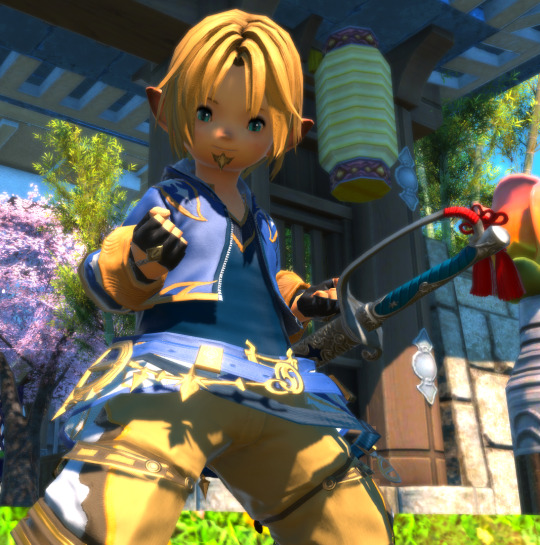
NAME: Kip Skyskip
AGE: 28
RACE: Plainsfolk Lalafell
GENDER: Male
SEXUALITY: Heterosexual Polyamorous
MARITAL STATUS: Married, Poly
SERVER: Balmung
Physical Appearance
HAIR: Long, sun-kissed blonde hair tied back into a long braid with low hanging bangs.
EYES: Sky Blue
HEIGHT: 3’2”
BUILD: Potato-shaped, while possessing a surprising upper body strength.
DISTINGUISHING MARKS: A small tuft of blonde hair on his ‘chin’ that he grows out in order to look more adult to those who dismiss Lalafell out of hand. Additionally, his hands and fingers are coarse from years of working with them.
COMMON ACCESSORIES: A tool box, fingerless black gloves, a pair of goggles to be used while working on sensitive equipment, schematics and other blueprints.
Personal
PROFESSION: Engineer, Voidsent Hunter, and Bar Manager of @menphinas-bosom.
HOBBIES: Crafting of all kinds, but primarily cooking. Furthermore, Kip enjoys putting together particularly intricate devices such as model airships or chronometers.
RESIDENCE: The Mist Apartments of Limsa Lominsa
BIRTHPLACE: Lower La Noscea
PATRON DEITY: Menphina, the Lover
FEARS: Taking the life of someone who doesn’t deserve it. Being thought of as a weak link. Being left behind.
Relationships
SPOUSE: Narani Bayaqud
CHILDREN: Skylo and Skymo (Twins, Only a few months old)
PARENTS: Norora Nora (Mother), Sukkipu Senpu (Father)
SIBLINGS: Roran Saran (Younger Brother), Koyiyi Koyi (Younger Sister), and roughly six other younger siblings. (Would not mind adding characters to the family on the off-chance anyone is interested in doing so.)
OTHER RELATIVES: Kento Oto (Grandfather, Deceased)
PETS: Suketto (Shiba Puppy)
Traits
extroverted / introverted / in between
disorganised / organised / in between
close minded / open-minded / in between
calm / anxious / in between
disagreeable / agreeable / in between
cautious / reckless / in between
patient / impatient / in between
outspoken / reserved / in between
leader / follower / in between
empathetic / unempathetic / in between
optimistic / pessimistic / in between
traditional / modern / in between
hard-working / lazy / in between
cultured / un-cultured / in between
loyal / disloyal / in between
faithful / unfaithful / in between
Additional Information
SMOKING HABIT: never / sometimes / frequently / to excess.
DRUGS: never / sometimes / frequently / to excess.
ALCOHOL: never / sometimes / frequently / to excess.
RP Hooks
Commissioned!: As an experienced omnicrafter, Kip tries to help fund both himself and Menphina’s as best he can. To that end, he frequently takes leves and other commissions from clients and tries his best to maintain a good relationship with all his customers, not just for repeat business, but to generally maintain a rapport. He would also not be opposed to teach others how to get into the nitty-gritty of crafting if they show interest in his work.
Til’ Sea Swallows All: Before the Calamity struck, Kip was pressed into service with the Maelstrom due to the pressure from his grandfather. Though his participation was begrudging, Kip started to make some progress before the Calamity dispersed him and his family from their homeland. After having ignited a far in his heart, Kip has returned to the Maelstrom and is looking help defend his homeland properly now as a Tactician.
Sorcery!: Due to having a natural affinity towards physical combat, Kip never truly developed his magical potential. In an attempt to find a place within the Maelstrom as a strategist, Kip has recently joined the Arcanist’s guild and is searching for ways to improve.
Echo, echo, echo..: After a harrowing experience in the East, Kip has discovered his latent Echo that has remained dormant all his life. Casting aside his purely pacifistic lifestyle in favor of accepting the responsibility that comes with such a gift, Kip has been trying to get in contact with others who share a similar power in order to figure out how best to use it.
Love Like You: Being in a polyamorous relationship brings great freedom to live and love. Unfortunately, the amount of ‘loving’ a male lalafell gets in comparison to his female au ra wife ends up being an impressive, albeit depressing gulf. The last few years have played hard and fast with Kip, and only recently has he gotten a chance to actually sit down, breathe, and maybe expand his horizons some without having to worry about being dragged into some blood feud. That in mind, Kip may be on the lookout for any physical and/or emotional encounters with the opposite sex, tying this hook directly with all the others should the interest be there. (Lalafell preference but Kip is fond of all races.)
Availability
I am in the EST timezone. My schedule is a bit in flux, but I’m usually accessible from 4-8 PM EST most nights, and then again around 11 or 12 PM EST to around 1-2 AM EST. Some nights I can be on from 4 PM to 2 AM depending on the day! I have some flexibility from week to week.
I prefer in-game RP but I’m more than happy to RP on Discord as well! Feel free to shoot me a message in my inbox if you’re interested in setting up some RP, or contact me if you happen to see me online in-game as well!
Really looking forward to branching out with Kip a bit more! I think it’s about time he interacted with others outside his inner circle.
#Final Fantasy 14#Final Fantasy XIV#ff14#FFXIV#Kip Skyskip#Lalafell#Plainsfolk#lf rp contacts#lf rp#Balmung
34 notes
·
View notes
Photo
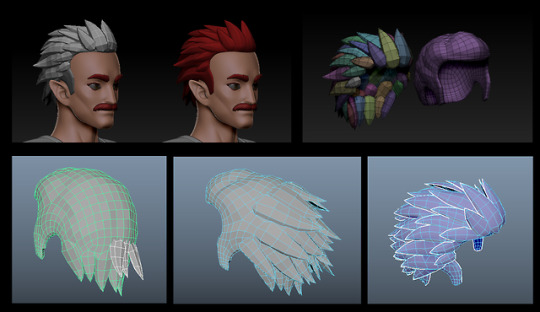
Cartoon Hair Tutorial - Part II
This tutorial expands on the previous hair tutorial I did (Part I is here!) I found that one of the most time consuming parts of creating NPC characters was producing a low poly mesh of the cartoon hair I had sculpted. This is my method for saving time and basically making my high-poly mesh and low-poly mesh at the same time, saving a big chunk of time on retopology.
Create an IMM brush that has the basic poly layout of your desired low poly hair. It should be relatively simple, and have the same density as it would if you were retopologizing the parts of the hair by hand. Use it in curve mode, and taper the size.
Just like in the previous tutorial, make a Dynamesh cap that's the basic size and shape of your hair, something to build on top of. Once you are satisfied with your sculpting, you can use ZRemesher to make a low-poly version of this cap with nice topology.
Start laying out curves with your low poly hair brush on top of the cap. Make sure they are embedded into the surface, and there is some overlap between the strand of hair and the base mesh, especially near the top of the strand.
Once you have all your hair laid out, and it looks pretty much like what you want the eventual product to look like, export the hair strands and cap set to their lowest subdivision level. You will use this for your low-poly model. (Image: Top-Right)
Copy the strands and cap, divide them until they are smooth, and then Dynamesh with a fair amount of density. Sculpt on this high poly version, and when you are done, you can export it for baking/retopo guidance. (Image of both high and low ZBrush meshes: Top-Left)
Now import the low-poly version into Maya. Split the hair into groups--I usually see what is overlapping each strand, and break it up into layers. Create your hair by combining these hair bits with the cap using Maya's Boolean function. (Mesh > Booleans > Union) This will produce some messy faces, so after I add each chunk, I usually do a Merge Vertices with a relatively small distance to get rid of some extra points, and do some manual topology tidying as well. After I have all the bits combined together, I run Mesh > Cleanup with "Select matching Polygons" and "Faces with more than 4 sides." With those weird n-gons selected, I Triangulate. Then I get rid of the inside of the cap facing the head, which is needed for the booleans to work, but is just excess polys.
Check to make sure this mesh matches up with your sculpt. If it does, UV it! Now you have your low poly hair. Bake and texture away!
#Miasma Caves#gamedev#indiedev#indie games#Game Art#artist#art#character art#tutorial#3d#maya#zbrush#Modeling
5 notes
·
View notes